Paul van Yperen's Blog, page 422
April 16, 2014
George Formby
George Formby (1904–1961) was Britain's most popular film comedian between 1934 and 1945, and one of the highest-paid stars. He appeared in 21 hit films, cut over 230 records, and entertained an estimated three million Allied Servicemen during World War II. His trademark was the banjo ukulele - along with his buck-toothed grin.
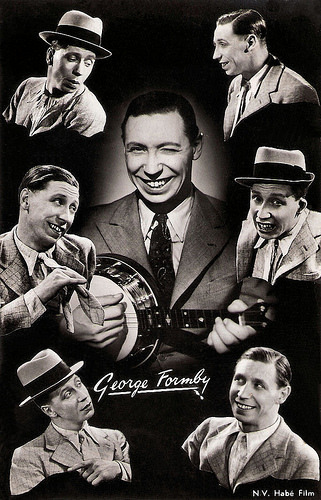
Dutch postcard. Image: N.V. Habé Film.
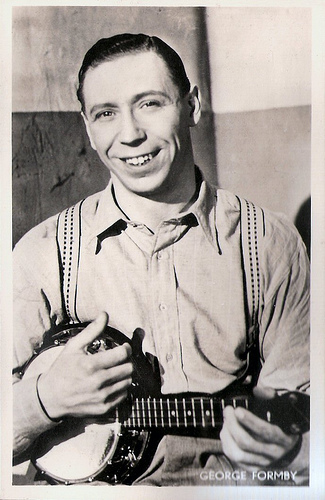
Dutch postcard by P.F. Cladder, Amsterdam, no. 49-62 kk. Photo: HABÉ Film.
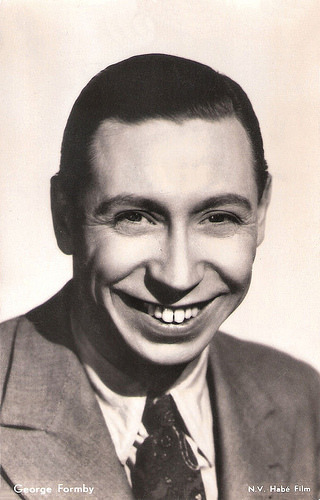
Dutch postcard by M. B. & Z., no. 1080, 1940. Photo: N.V. Habé Film. Publicity still for Keep Your Seats, Please (Monty Banks, 1936).
Accident-prone Innocent
George Formby was born in Wigan, Lancashire, in 1905, as George Hoy Booth, the eldest of seven children. He was born blind due to an obstructive caul; his sight was restored during a violent coughing fit or sneeze when he was a few months old.
His father, George Formby Senior (real name James Booth), was a famous stage actor and comedian. He never wanted any of his family to enter show business and so George Jr., was apprenticed as a jockey when he was seven and rode his first professional race at ten.
On the death of his father in 1921, Formby jr. abandoned his career as a jockey and started his own music hall career using his father's material. In 1924 he married dancer Beryl Ingham, who managed his career until her death in 1960.
He allegedly took up the ukulele, for which he was later famous, as a hobby; he first played it on stage for a bet. In film and on stage, he generally adopted the character of the Cheekie-Chappy, an honest, good-hearted but accident-prone innocent who used the phrases: "It's turned out nice again!" as an opening line; "Ooh, mother!" when escaping from trouble; and a timid "Never touched me!" after losing a fistfight.
What made him stand out, however, was his unique and often mimicked musical style. He sang comic songs, full of double entendre, to his own accompaniment on the ukelele-banjo. He played it in a highly syncopated style, referred to as the 'Formby style'.
Some of his songs were considered too rude for broadcasting. His 1937 song, With my little stick of Blackpool Rock was banned by the BBC because of the lyrics, but Formby's cheerful, innocent demeanor and nasal, high-pitched Lancashire accent neutralized the shock value of the lyrics.
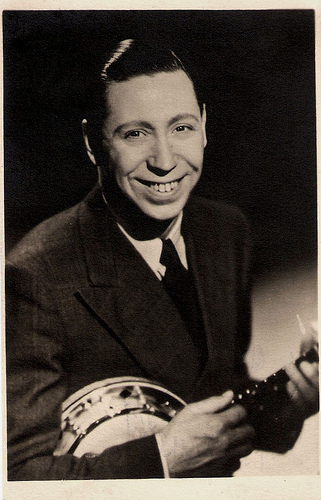
British card.
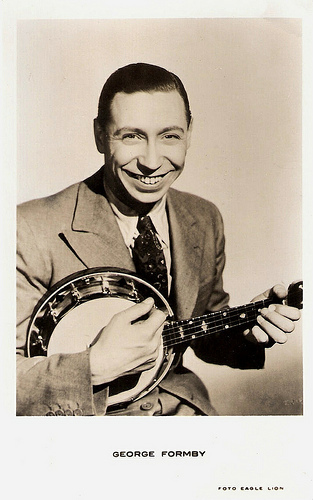
Dutch postcard by Hemo. Photo: Eagle Lion.
Gormless Incompetents
George Formby appeared in a sole silent film, By the Shortest of Heads (Bert Haldane, 1915), and in 1934 he made his first sound film Boots! Boots! (Bert Tracy, 1934).
The film was successful and he signed a contract to make a further eleven with Associated Talking Pictures, which earned him a then-astronomical income of £100,000 per year.
In his films he played essentially gormless incompetents, aspiring to various kinds of professional success (as cyclist or jockey) and even more improbably to a middle-class girlfriend, usually in the clutches of some caddish type with a moustache.
Invariably he scored on both counts, in such films as No Limit (Monty Banks, 1935), Keep Fit (Anthony Kimmins, 1937), and Trouble Brewing (Anthony Kimmins, 1939).
Between 1934 and 1945 Formby was the top comedian in British cinema, and at the height of his film popularity, Let George Do It (Marcel Varnel, 1940) with Phyllis Calvert , was exported to America. This espionage comedy is still regarded as probably his best.
George is a member of a concert party, who takes the wrong ship by mistake during a blackout, and finds himself in Norway (mistaking Bergen for Blackpool) as a secret agent. A dream sequence in which he punches Adolph Hitler on the nose and addresses him as a 'windbag' is one of the most enduring moments in film comedy.
In the post-war years, the Formbys toured Australia and New Zealand, Scandinavia and Canada, and in 1951 George took the West End by storm in the new musical Zip Goes A Million.
A weak heart led to his official retirement in 1952 although he had since occasionally appeared on the stage and in pantomimes.
His final heart attack occurred at the home of his fiancée, Patricia Howson, 36. The announcement of their engagement was a surprise to many, coming as it did just two months after the death of Beryl. An estimated 100,000 mourners lined the route as George Formby's coffin was driven to the cemetery.
George Formby sings When i'm cleaning windows in Keep Your Seats, Please (1936). Source: Petey1308 (YouTube).
George Formby sings Our Sergeant Major in It's in the Air (1938). Source: Petey1308 (YouTube).
Sources: Brian McFarlane (Encyclopedia of British Film), BBC, The George Formby Society, Wikipedia, and .

Dutch postcard. Image: N.V. Habé Film.

Dutch postcard by P.F. Cladder, Amsterdam, no. 49-62 kk. Photo: HABÉ Film.

Dutch postcard by M. B. & Z., no. 1080, 1940. Photo: N.V. Habé Film. Publicity still for Keep Your Seats, Please (Monty Banks, 1936).
Accident-prone Innocent
George Formby was born in Wigan, Lancashire, in 1905, as George Hoy Booth, the eldest of seven children. He was born blind due to an obstructive caul; his sight was restored during a violent coughing fit or sneeze when he was a few months old.
His father, George Formby Senior (real name James Booth), was a famous stage actor and comedian. He never wanted any of his family to enter show business and so George Jr., was apprenticed as a jockey when he was seven and rode his first professional race at ten.
On the death of his father in 1921, Formby jr. abandoned his career as a jockey and started his own music hall career using his father's material. In 1924 he married dancer Beryl Ingham, who managed his career until her death in 1960.
He allegedly took up the ukulele, for which he was later famous, as a hobby; he first played it on stage for a bet. In film and on stage, he generally adopted the character of the Cheekie-Chappy, an honest, good-hearted but accident-prone innocent who used the phrases: "It's turned out nice again!" as an opening line; "Ooh, mother!" when escaping from trouble; and a timid "Never touched me!" after losing a fistfight.
What made him stand out, however, was his unique and often mimicked musical style. He sang comic songs, full of double entendre, to his own accompaniment on the ukelele-banjo. He played it in a highly syncopated style, referred to as the 'Formby style'.
Some of his songs were considered too rude for broadcasting. His 1937 song, With my little stick of Blackpool Rock was banned by the BBC because of the lyrics, but Formby's cheerful, innocent demeanor and nasal, high-pitched Lancashire accent neutralized the shock value of the lyrics.

British card.

Dutch postcard by Hemo. Photo: Eagle Lion.
Gormless Incompetents
George Formby appeared in a sole silent film, By the Shortest of Heads (Bert Haldane, 1915), and in 1934 he made his first sound film Boots! Boots! (Bert Tracy, 1934).
The film was successful and he signed a contract to make a further eleven with Associated Talking Pictures, which earned him a then-astronomical income of £100,000 per year.
In his films he played essentially gormless incompetents, aspiring to various kinds of professional success (as cyclist or jockey) and even more improbably to a middle-class girlfriend, usually in the clutches of some caddish type with a moustache.
Invariably he scored on both counts, in such films as No Limit (Monty Banks, 1935), Keep Fit (Anthony Kimmins, 1937), and Trouble Brewing (Anthony Kimmins, 1939).
Between 1934 and 1945 Formby was the top comedian in British cinema, and at the height of his film popularity, Let George Do It (Marcel Varnel, 1940) with Phyllis Calvert , was exported to America. This espionage comedy is still regarded as probably his best.
George is a member of a concert party, who takes the wrong ship by mistake during a blackout, and finds himself in Norway (mistaking Bergen for Blackpool) as a secret agent. A dream sequence in which he punches Adolph Hitler on the nose and addresses him as a 'windbag' is one of the most enduring moments in film comedy.
In the post-war years, the Formbys toured Australia and New Zealand, Scandinavia and Canada, and in 1951 George took the West End by storm in the new musical Zip Goes A Million.
A weak heart led to his official retirement in 1952 although he had since occasionally appeared on the stage and in pantomimes.
His final heart attack occurred at the home of his fiancée, Patricia Howson, 36. The announcement of their engagement was a surprise to many, coming as it did just two months after the death of Beryl. An estimated 100,000 mourners lined the route as George Formby's coffin was driven to the cemetery.
George Formby sings When i'm cleaning windows in Keep Your Seats, Please (1936). Source: Petey1308 (YouTube).
George Formby sings Our Sergeant Major in It's in the Air (1938). Source: Petey1308 (YouTube).
Sources: Brian McFarlane (Encyclopedia of British Film), BBC, The George Formby Society, Wikipedia, and .
Published on April 16, 2014 23:00
April 15, 2014
Vera Voronina
Ukrainian actress Vera Voronina (1905-?) had a short but shining career in the late silent era, in Berlin as well as in Hollywood.
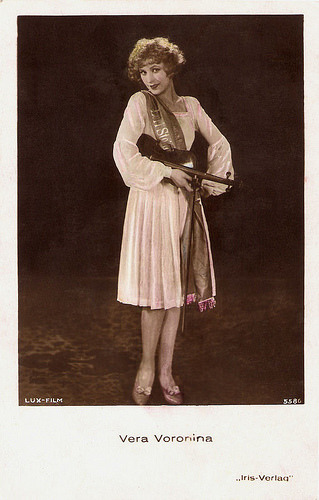
Austrian postcard by Iris-Verlag, no. 5586. Photo: Lux-Film.
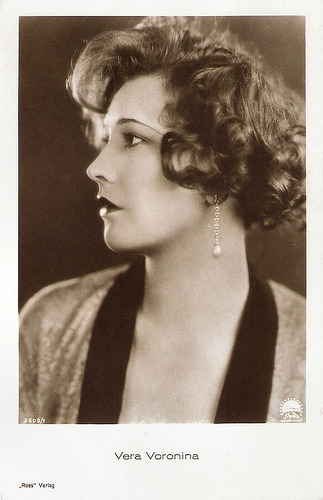
German postcard by Ross Verlag, no. 3503/1, 1928-1929. Photo: Paramount.
Russia, Sweden, Austria, Germany
Vera Voronina aka Wera Woronina was born in Kiev, then part of the Russian Empire (now Ukrain) in 1905.
During the Russian revolution her family fled to Sweden.
There she made her film debut in the silent production Hon den enda/Never Say... Never! (Gustav Molander, 1926). She played the female lead opposite Austrian silent film star Alphons Fryland .
The film was probably an adaptation of Alfred de Musset's play Il ne faut jurer rien (You should swear nothing), about a spendthrift young man.
Vera then moved to Austria to play in Haifische der Nachkriegszeit/Sharks of the post-war period (Eugen Preiss, Louis Seeman, 1926).
Probably her first German film was Das deutsche Mutterherz/The Heart of a German Mother (Geza von Bolvary, 1926), starring Margarete Kupfer and a young Heinz Ruhmann in his film debut as her bad son.
Then Voronina played a part in the Austrian production Schwiegersöhne/The Sons-in-law (Hanns Steinhoff, 1926) starring the Danish comic duo Fy og By (aka Pat and Patachon).
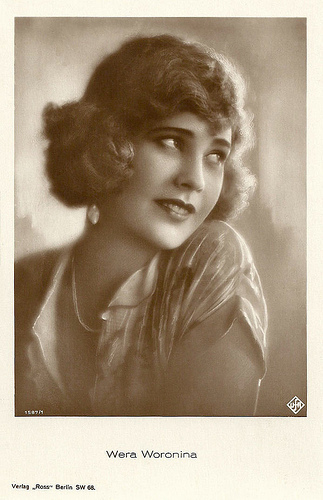
German postcard by Ross Verlag, no. 1587/1, 1927-1928. Photo: Ufa.
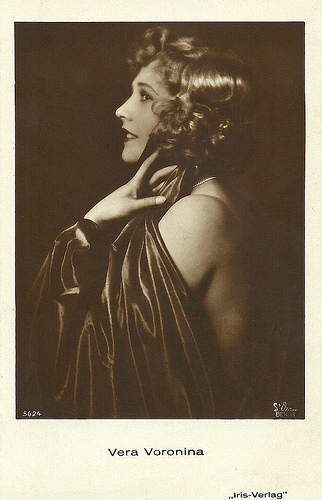
Austrian postcard by Iris Verlag, no. 5624. Photo: D'Ora (Dora Kallmus), Arthur Benda. Collection: Didier Hanson.
Hollywood, London, Hollywood, Berlin
Vera Voronina crossed the Atlantic to play for Paramount in two Hollywood movies: the romantic drama The Whirlwind of Youth (Rowland Lee, 1927) starring Lois Moran, and the comedy Time to Love (Frank Tuttle, 1927), in which Vera had the female lead opposite Raymond Griffith and William Powell.
Subsequently she went to Britain to star in George Pearson's silent adventure film Huntingtower (1928), starring Harry Lauder and Patrick Aherne.Voronina played Russian princess Saskia who is imprisoned in a deserted castle and is saved by a modern day grocer.
She then returned to Hollywood to play Mademoiselle Lapoukhine in Ernst Lubitsch ' famous film The Patriot (1928), starring Emil Jannings . It was oone of the first films that won an Academy Award.
The Patriot was nominated for five Oscars. It won the Academy Award for Best Writing Achievement and was nominated for Best Actor in a Leading Role (Lewis Stone), Best Art Direction, Best Director and Best Picture. It is said to contain one of Jannings' best performances as Mad Czar Paul I, but we can't check it, because it is now one of the most sought after of all 'lost' films. Only pieces of the film are left.
Sound film finished off the Hollywood careers of both Jannings and Voronina. Their accents were too heavy and both returned to Germany.
Vera played supporting parts in Jaap Speijer's G'schichten aus dem Wienerwald/Tales from the Viennese forest (1928), Vererbte Triebe: Der Kampf ums neue Geschlecht/Inherited desires (Gustav Ucicky, 1929) starring Walter Rilla , and Wer wird dann weinen, wenn man aus einander geht/No Use Crying If Your Sweetheart Goes Away (Richard Eichberg, 1929) with Dina Gralla .
Finally, she played the lead role in the German-Czech production Aufruhr des Blutes/Rebellion of the blood (Victor Trivas, 1929) with Oscar Marion .
Vera Voronina retired when the sound film was introduced and nothing more was heard of her. If you have more information about her, please let us know.
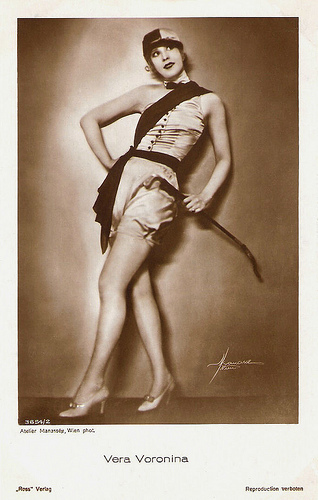
German postcard by Ross Verlag, no. 3654/2, 1928-1929. Photo: Atelier Manassé , Vienna.
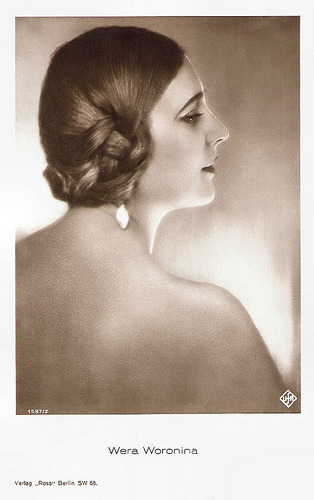
German postcard by Ross Verlag, no. 1587/2, 1928-1929. Photo: Ufa.
Sources: Thomas Staedeli (Cyranos), Wikipedia and .

Austrian postcard by Iris-Verlag, no. 5586. Photo: Lux-Film.

German postcard by Ross Verlag, no. 3503/1, 1928-1929. Photo: Paramount.
Russia, Sweden, Austria, Germany
Vera Voronina aka Wera Woronina was born in Kiev, then part of the Russian Empire (now Ukrain) in 1905.
During the Russian revolution her family fled to Sweden.
There she made her film debut in the silent production Hon den enda/Never Say... Never! (Gustav Molander, 1926). She played the female lead opposite Austrian silent film star Alphons Fryland .
The film was probably an adaptation of Alfred de Musset's play Il ne faut jurer rien (You should swear nothing), about a spendthrift young man.
Vera then moved to Austria to play in Haifische der Nachkriegszeit/Sharks of the post-war period (Eugen Preiss, Louis Seeman, 1926).
Probably her first German film was Das deutsche Mutterherz/The Heart of a German Mother (Geza von Bolvary, 1926), starring Margarete Kupfer and a young Heinz Ruhmann in his film debut as her bad son.
Then Voronina played a part in the Austrian production Schwiegersöhne/The Sons-in-law (Hanns Steinhoff, 1926) starring the Danish comic duo Fy og By (aka Pat and Patachon).

German postcard by Ross Verlag, no. 1587/1, 1927-1928. Photo: Ufa.

Austrian postcard by Iris Verlag, no. 5624. Photo: D'Ora (Dora Kallmus), Arthur Benda. Collection: Didier Hanson.
Hollywood, London, Hollywood, Berlin
Vera Voronina crossed the Atlantic to play for Paramount in two Hollywood movies: the romantic drama The Whirlwind of Youth (Rowland Lee, 1927) starring Lois Moran, and the comedy Time to Love (Frank Tuttle, 1927), in which Vera had the female lead opposite Raymond Griffith and William Powell.
Subsequently she went to Britain to star in George Pearson's silent adventure film Huntingtower (1928), starring Harry Lauder and Patrick Aherne.Voronina played Russian princess Saskia who is imprisoned in a deserted castle and is saved by a modern day grocer.
She then returned to Hollywood to play Mademoiselle Lapoukhine in Ernst Lubitsch ' famous film The Patriot (1928), starring Emil Jannings . It was oone of the first films that won an Academy Award.
The Patriot was nominated for five Oscars. It won the Academy Award for Best Writing Achievement and was nominated for Best Actor in a Leading Role (Lewis Stone), Best Art Direction, Best Director and Best Picture. It is said to contain one of Jannings' best performances as Mad Czar Paul I, but we can't check it, because it is now one of the most sought after of all 'lost' films. Only pieces of the film are left.
Sound film finished off the Hollywood careers of both Jannings and Voronina. Their accents were too heavy and both returned to Germany.
Vera played supporting parts in Jaap Speijer's G'schichten aus dem Wienerwald/Tales from the Viennese forest (1928), Vererbte Triebe: Der Kampf ums neue Geschlecht/Inherited desires (Gustav Ucicky, 1929) starring Walter Rilla , and Wer wird dann weinen, wenn man aus einander geht/No Use Crying If Your Sweetheart Goes Away (Richard Eichberg, 1929) with Dina Gralla .
Finally, she played the lead role in the German-Czech production Aufruhr des Blutes/Rebellion of the blood (Victor Trivas, 1929) with Oscar Marion .
Vera Voronina retired when the sound film was introduced and nothing more was heard of her. If you have more information about her, please let us know.

German postcard by Ross Verlag, no. 3654/2, 1928-1929. Photo: Atelier Manassé , Vienna.

German postcard by Ross Verlag, no. 1587/2, 1928-1929. Photo: Ufa.
Sources: Thomas Staedeli (Cyranos), Wikipedia and .
Published on April 15, 2014 23:00
April 14, 2014
Amedeo Nazzari
Italian heartthrob Amedeo Nazzari (1907-1979) was the athletic, fearless hero and impeccable gentleman of dozens of popular films during the late 1930s, 1940s and 1950s. Because of his reckless, adventure-seeking film characters he was compared to Errol Flynn. After the war he made a come-back opposite Yvonne Sanson in a series of popular crime-melodramas, directed by Raffaello Matarazzo. And he showed an admirable sense of irony in his portrayal of a film star in decline in Fellini’s Le notti di Cabiria (1957).
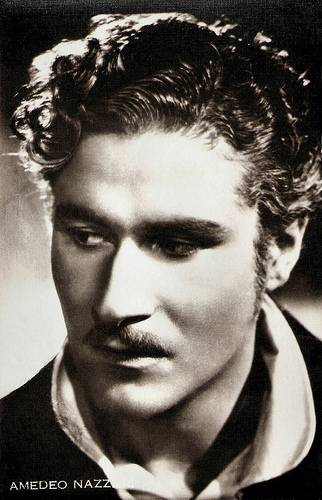
Vintage postcard.
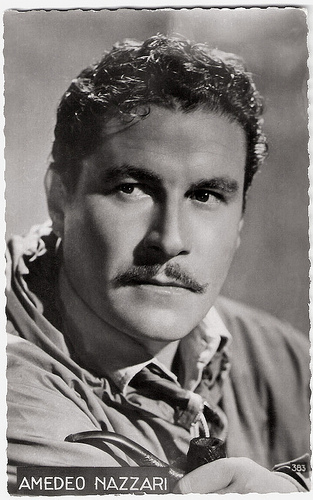
French postcard by Editions P.I., offered by Les Carbones Korès, Paris, no. 383.
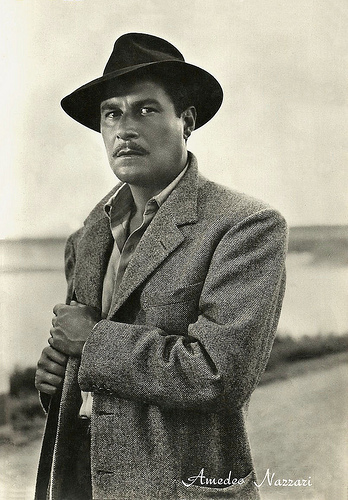
Italian postcard by Rotalfoto, no. 113. Photo: Ponti-De Laurentiis. Probably a still for Il brigante Musolino (1950), costarring Dino De Laurentiis' wife Silvana Mangano .
Difficult and Rebellious
Amedeo Nazzari was born as Salvatore Amedeo Buffa in Cagliari on the island of Sardinia in 1907. His father Salvatore Buffa was a factory owner and his mother was the daughter of Argenide Amedeo Nazzari, former President of the Court of Appeal of Vicenza. His father died when Amedeo was six and his mother moved with him and his sisters to Rome.
There he appeared in school plays. Later he abandoned his engineering studies for a career in the theatre. He made his professional debut at the company of Dillo Lombardi in 1927. In later years he worked for major companies like those of Annibale Ninchi , Memo Benassi and Marta Abba.
In 1935 he was noticed by Elsa Merlini , who offered him a part in her next film. This film, Almieri of Geneva (1936), was not a success, and Nazzari returned to the theatre.
Once again an actress noticed him: the young Anna Magnani , who insisted that her husband, director Goffredo Alessandrini, would give Amedeo a part in his new film Cavalleria/Cavalry (1936).
Amedeo's athletic figure and fascinating presence became the main attraction of the film, which was presented at the Venezia alla Mostra del Cinema (the Venice Film Festival) and then became one of the greatest box office hits in the Italian cinemas that year.
Another film role in uniform, in Luciano Serra pilota/Luciano Serra, pilot (Goffredo Alessandrini, 1938), gave him his second popular success. Although the film was made under the Fascist regime, it is terse and not at all bogged down by rhetoric, according to F.T. at the Italica website of Rai Internazionale .
Nazzari was now a familiar face and received many film offers. His continuing discussions with film makers about how to interpret dialogues and his suggestions to change scripts gave him the reputation of being difficult and rebellious.
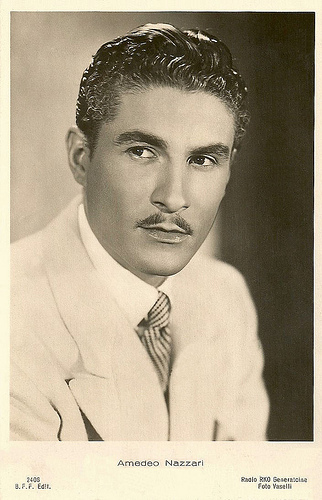
Italian postcard by Ballerini & Frattini Firenze Ed., no. 2408. Photo Vaselli / Radio RKO Generalcine.
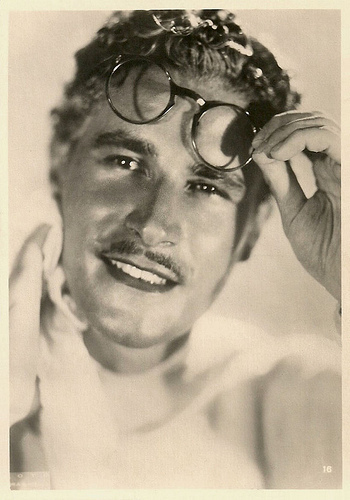
Italian postcard by ASER (A. Scaramaglia Edizioni Roma), 1941.
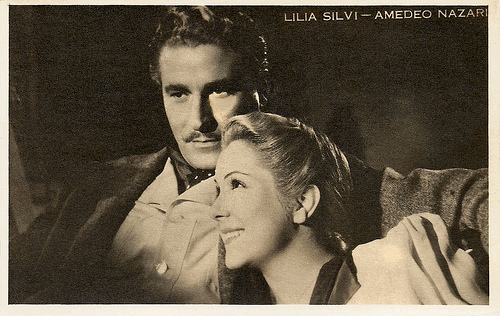
Italian postcard. With Lilia Silvi .
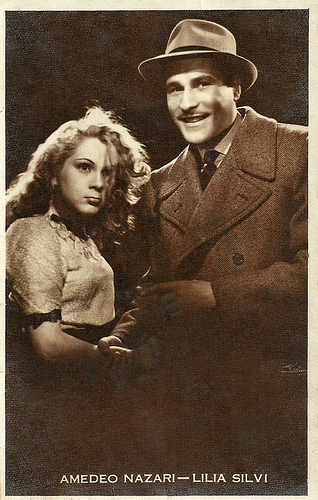
Italian postcard. Lilia Silvi and Amedeo Nazzari in La bisbetica domata/The Taming of the Shrew (Ferdinando Maria Poggioli, 1942).
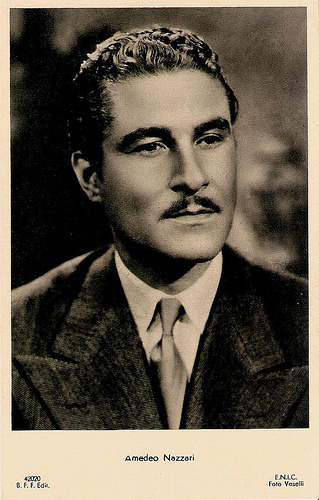
Italian postcard by Casa Editrice Ballerini & Fratini (B.F.F. Edit.), Firenze, no. 42020. Photo: Voselli / E.N.I.C.
The First Topless Nude Scene
In 1941, Amedeo Nazzari received the Volpi cup for Best Actor at at the ninth Venice Film Festival. He was awarded for his role in Caravaggio, il pittore maledetto/Caravaggio, the cursed painter (Goffredo Alessandrini, 1941) opposite Clara Calami .
A huge success was the costume drama La cena della beffa/The dinner of the practical jokes (Allessandro Blasetti, 1941). This celebrated adaptation of the Sem Benelli play definitively confirmed his status as a film star. In this historical drama he had a striking resemblance to Errol Flynn.
The film created a sensation with the first topless nude scene in a mainstream Italian film. In a brief but startling scene luminous leading lady Clara Calami 's blouse is ripped off by the lusty Nazzari.
On IMDb , Mario Gauci writes: “the film is stylish and handsomely mounted - though its stage origins are betrayed by being mostly filmed in interiors. Still, the highly intriguing plot - with its many twists and turns (particularly towards the ironic, even Shakespearean, finale) - keeps one compelled to watch and the performances are all quite good”.
After some smaller films and a difficult period after the war he returned in grand style in the war drama Un giorno nella vita/A Day in the Life (Allessandro Blasetti, 1946), the crime drama Il bandito/The Bandit (Alberto Lattuada, 1946) opposite Anna Magnani , and the Alexander Pushkin adaptation La figlia del capitano/The Captain's Daughter (Mario Camerini, 1946) with Vittorio Gassman .
Internationally, he was also in high demand. He first went to Spain to appear in three films by Ricardo Gascón, and then moved to Argentina. When he refused to play a criminal and corrupt Italian and so to defame his country, even Evita Peron came to his defence.
He returned to Italy in 1949, and appeared with Silvana Mangano in the compelling melodrama Il lupo della Sila/The Lure of the Sila (Duilio Coletti, 1949), and with Greek actress Yvonne Sanson in Catene/Chains (1949, Raffaello Matarazzo).
Catene was the start of a second period of film successes for Nazzari. With Sanson and director Raffaello Matarazzo he made s series of ‘strappalacrime’, crime-melodramas which were despised by the film critics but loved by the public. Among this series were also Tormento/Torment (1950), I figli di nessuno/Nobody’s Children (1951), and Torna!/Go! (1954). In Italy these films became a camp phenomenon among B-film fans in the 1970s.
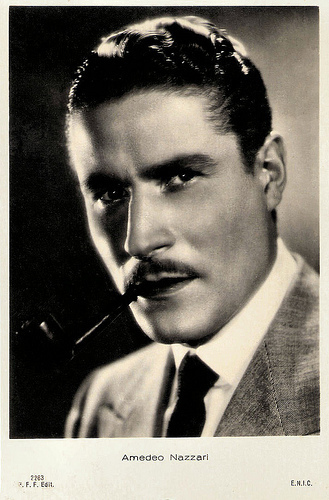
Italian postcard by B.F.F. Edit., Firenze, no. 2263. Photo: E.N.I.C.
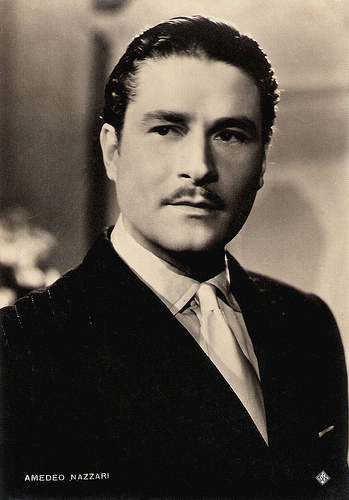
Italian postcard by ASER (A. Scaramaglia Edizioni, Roma), no. 10. Photo: Lux Film / Vaselli, Roma.
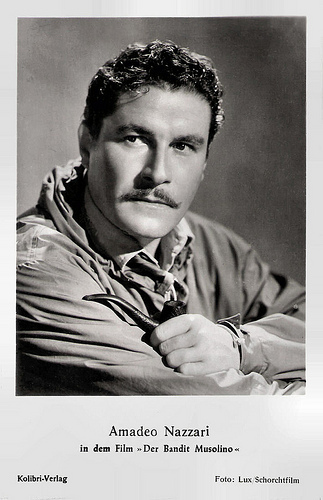
German postcard by Kolobri-Verlag. Photo: Lux / Schorchtfilm. Publicity still for Il brigante Musolino/Fugitive (Mario Camerini, 1950).
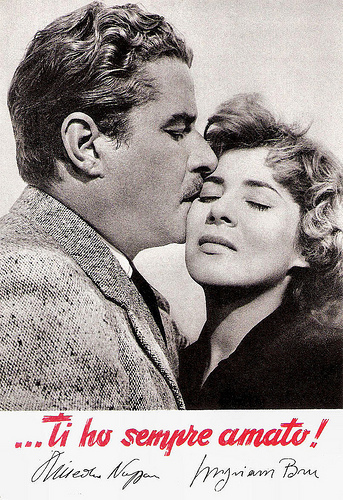
Italian promotion card by D.E.A.R. Film. Photo: Rizzoli / Royal Film / D.E.A.R. Film. Publicity still for ...ti ho sempre amato!/I Always Loved You (Mario Costa, 1953) with Myriam Bru .
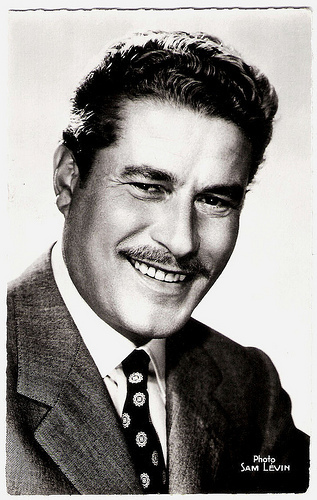
French postcard by Editions du Globe, Paris, no. 461. Photo Sam Lévin.
Impeccable Professionalism
During the 1950s, Amedeo Nazarri appeared also in more serious films. In Processo alla città/The City Stands Trial (Luigi Zampa, 1952) he played a judge who opposes the Neapolitan Camorra, and in Proibito/Forbidden (Mario Monicelli, 1955) starring Mel Ferrer, he had for the first time the opportunity to play a character in a Sardinian history of family feuds.
In 1957 he gently chided his virile, romantic screen image as the self-absorbed film-star-in-decline opposite Giulietta Masina in the Oscar winning Le notti di Cabiria/Nights of Cabiria (Federico Fellini, 1957). Here he cocked an eye at himself with an admirable sense of irony.
Also in 1957 Nazzari married Greek-Italian actress Irene Genna, and a year later Maria Evelina Nazzari was born, who is now also a theatre actress.
The 1960s began with two disappointments: the role of Prince Salina in Il Gattopardo/The Leopard (1960), which was offered to him by director Luchino Visconti then went to Burt Lancaster to raise money from the American producers.
Earlier his role in La tempesta/The Tempest (Alberto Lattuada, 1958), a remake of his La figlia del capitano, was assigned to Van Heflin. From Hollywood came a proposal to make a film with Marilyn Monroe, but this time it was Nazzari himself who refused because of his difficulties with speaking and singing English (the film, Let's Make Love, would be made with Yves Montand ).
In 1968 he did obtain a part in the Romanian production Columna/The Column (Mircea Dragan, 1968) with Antonella Lualdi and Franco Interlenghi .
In Italy started the golden age of the Italian comedy, but except for some sporadic appearances, Nazzari refused the offers. According to Wikipedia , he explained that it was “a matter of taste and respect for himself and the public”.
He only did cameo appearances in international productions like the crime dramas The Poppy Is Also a Flower (Terence Young, 1966) with Senta Berger , Le clan des Siciliens/The Sicilian Clan (Henri Verneuil, 1969) with Jean Gabin , and The Valachi Papers (Terence Young, 1972) starring Charles Bronson.
He worked more satisfyingly for television. He made a TV remake of La Figlia del capitano/The Captain's Daughter (Leonardo Cortese, 1965), and appeared as a guest on such shows as Il Musichiere (The Musician), Studio Uno and Settevoci.
During the 1970s, kidney problems force him to several hospital admissions. In 1976 he played a guest part in the German krimi series Derrick.
His last film appearances were small roles in A Matter of Time/Nina (Vincente Minnelli, 1976) with Ingrid Bergman , and Melodrammore (Maurizio Costanzo, 1977).
Amedeo Nazzari died in 1979 in a Roman hospital.
During his career he won several awards. He won the Best Actor award at the Venice Film Festival twice, in 1941 and 1947. He was also awarded the Special David di Donatello prize, for a life dedicated to cinema with passionate professionalism and extraordinary success.
At Italica , F.T. writes: “Ever faithful to his embodiments of fearless heroes and incorruptible gentleman, Nazzari was an icon of a naïve, provincial Italy that was autarkic at all costs, even in its dreams: but he displayed an ability to shift from ‘Magyar’ comedy to mature roles with impeccable professionalism, the ultimate defining trait of his outstanding career.”
Final scene from La cena delle beffe (1941) with Amedeo Nazzari and Osvaldo Valenti. Source: fusiota73 (YouTube).
Original trailer of Le Notti di Cabiria (1957). Source: TrailerItaliano (YouTube).
Sources: Hal Erickson (AllMovie), F.T. (Italica), Wikipedia (Italian) and

Vintage postcard.

French postcard by Editions P.I., offered by Les Carbones Korès, Paris, no. 383.

Italian postcard by Rotalfoto, no. 113. Photo: Ponti-De Laurentiis. Probably a still for Il brigante Musolino (1950), costarring Dino De Laurentiis' wife Silvana Mangano .
Difficult and Rebellious
Amedeo Nazzari was born as Salvatore Amedeo Buffa in Cagliari on the island of Sardinia in 1907. His father Salvatore Buffa was a factory owner and his mother was the daughter of Argenide Amedeo Nazzari, former President of the Court of Appeal of Vicenza. His father died when Amedeo was six and his mother moved with him and his sisters to Rome.
There he appeared in school plays. Later he abandoned his engineering studies for a career in the theatre. He made his professional debut at the company of Dillo Lombardi in 1927. In later years he worked for major companies like those of Annibale Ninchi , Memo Benassi and Marta Abba.
In 1935 he was noticed by Elsa Merlini , who offered him a part in her next film. This film, Almieri of Geneva (1936), was not a success, and Nazzari returned to the theatre.
Once again an actress noticed him: the young Anna Magnani , who insisted that her husband, director Goffredo Alessandrini, would give Amedeo a part in his new film Cavalleria/Cavalry (1936).
Amedeo's athletic figure and fascinating presence became the main attraction of the film, which was presented at the Venezia alla Mostra del Cinema (the Venice Film Festival) and then became one of the greatest box office hits in the Italian cinemas that year.
Another film role in uniform, in Luciano Serra pilota/Luciano Serra, pilot (Goffredo Alessandrini, 1938), gave him his second popular success. Although the film was made under the Fascist regime, it is terse and not at all bogged down by rhetoric, according to F.T. at the Italica website of Rai Internazionale .
Nazzari was now a familiar face and received many film offers. His continuing discussions with film makers about how to interpret dialogues and his suggestions to change scripts gave him the reputation of being difficult and rebellious.

Italian postcard by Ballerini & Frattini Firenze Ed., no. 2408. Photo Vaselli / Radio RKO Generalcine.

Italian postcard by ASER (A. Scaramaglia Edizioni Roma), 1941.

Italian postcard. With Lilia Silvi .

Italian postcard. Lilia Silvi and Amedeo Nazzari in La bisbetica domata/The Taming of the Shrew (Ferdinando Maria Poggioli, 1942).

Italian postcard by Casa Editrice Ballerini & Fratini (B.F.F. Edit.), Firenze, no. 42020. Photo: Voselli / E.N.I.C.
The First Topless Nude Scene
In 1941, Amedeo Nazzari received the Volpi cup for Best Actor at at the ninth Venice Film Festival. He was awarded for his role in Caravaggio, il pittore maledetto/Caravaggio, the cursed painter (Goffredo Alessandrini, 1941) opposite Clara Calami .
A huge success was the costume drama La cena della beffa/The dinner of the practical jokes (Allessandro Blasetti, 1941). This celebrated adaptation of the Sem Benelli play definitively confirmed his status as a film star. In this historical drama he had a striking resemblance to Errol Flynn.
The film created a sensation with the first topless nude scene in a mainstream Italian film. In a brief but startling scene luminous leading lady Clara Calami 's blouse is ripped off by the lusty Nazzari.
On IMDb , Mario Gauci writes: “the film is stylish and handsomely mounted - though its stage origins are betrayed by being mostly filmed in interiors. Still, the highly intriguing plot - with its many twists and turns (particularly towards the ironic, even Shakespearean, finale) - keeps one compelled to watch and the performances are all quite good”.
After some smaller films and a difficult period after the war he returned in grand style in the war drama Un giorno nella vita/A Day in the Life (Allessandro Blasetti, 1946), the crime drama Il bandito/The Bandit (Alberto Lattuada, 1946) opposite Anna Magnani , and the Alexander Pushkin adaptation La figlia del capitano/The Captain's Daughter (Mario Camerini, 1946) with Vittorio Gassman .
Internationally, he was also in high demand. He first went to Spain to appear in three films by Ricardo Gascón, and then moved to Argentina. When he refused to play a criminal and corrupt Italian and so to defame his country, even Evita Peron came to his defence.
He returned to Italy in 1949, and appeared with Silvana Mangano in the compelling melodrama Il lupo della Sila/The Lure of the Sila (Duilio Coletti, 1949), and with Greek actress Yvonne Sanson in Catene/Chains (1949, Raffaello Matarazzo).
Catene was the start of a second period of film successes for Nazzari. With Sanson and director Raffaello Matarazzo he made s series of ‘strappalacrime’, crime-melodramas which were despised by the film critics but loved by the public. Among this series were also Tormento/Torment (1950), I figli di nessuno/Nobody’s Children (1951), and Torna!/Go! (1954). In Italy these films became a camp phenomenon among B-film fans in the 1970s.

Italian postcard by B.F.F. Edit., Firenze, no. 2263. Photo: E.N.I.C.

Italian postcard by ASER (A. Scaramaglia Edizioni, Roma), no. 10. Photo: Lux Film / Vaselli, Roma.

German postcard by Kolobri-Verlag. Photo: Lux / Schorchtfilm. Publicity still for Il brigante Musolino/Fugitive (Mario Camerini, 1950).

Italian promotion card by D.E.A.R. Film. Photo: Rizzoli / Royal Film / D.E.A.R. Film. Publicity still for ...ti ho sempre amato!/I Always Loved You (Mario Costa, 1953) with Myriam Bru .

French postcard by Editions du Globe, Paris, no. 461. Photo Sam Lévin.
Impeccable Professionalism
During the 1950s, Amedeo Nazarri appeared also in more serious films. In Processo alla città/The City Stands Trial (Luigi Zampa, 1952) he played a judge who opposes the Neapolitan Camorra, and in Proibito/Forbidden (Mario Monicelli, 1955) starring Mel Ferrer, he had for the first time the opportunity to play a character in a Sardinian history of family feuds.
In 1957 he gently chided his virile, romantic screen image as the self-absorbed film-star-in-decline opposite Giulietta Masina in the Oscar winning Le notti di Cabiria/Nights of Cabiria (Federico Fellini, 1957). Here he cocked an eye at himself with an admirable sense of irony.
Also in 1957 Nazzari married Greek-Italian actress Irene Genna, and a year later Maria Evelina Nazzari was born, who is now also a theatre actress.
The 1960s began with two disappointments: the role of Prince Salina in Il Gattopardo/The Leopard (1960), which was offered to him by director Luchino Visconti then went to Burt Lancaster to raise money from the American producers.
Earlier his role in La tempesta/The Tempest (Alberto Lattuada, 1958), a remake of his La figlia del capitano, was assigned to Van Heflin. From Hollywood came a proposal to make a film with Marilyn Monroe, but this time it was Nazzari himself who refused because of his difficulties with speaking and singing English (the film, Let's Make Love, would be made with Yves Montand ).
In 1968 he did obtain a part in the Romanian production Columna/The Column (Mircea Dragan, 1968) with Antonella Lualdi and Franco Interlenghi .
In Italy started the golden age of the Italian comedy, but except for some sporadic appearances, Nazzari refused the offers. According to Wikipedia , he explained that it was “a matter of taste and respect for himself and the public”.
He only did cameo appearances in international productions like the crime dramas The Poppy Is Also a Flower (Terence Young, 1966) with Senta Berger , Le clan des Siciliens/The Sicilian Clan (Henri Verneuil, 1969) with Jean Gabin , and The Valachi Papers (Terence Young, 1972) starring Charles Bronson.
He worked more satisfyingly for television. He made a TV remake of La Figlia del capitano/The Captain's Daughter (Leonardo Cortese, 1965), and appeared as a guest on such shows as Il Musichiere (The Musician), Studio Uno and Settevoci.
During the 1970s, kidney problems force him to several hospital admissions. In 1976 he played a guest part in the German krimi series Derrick.
His last film appearances were small roles in A Matter of Time/Nina (Vincente Minnelli, 1976) with Ingrid Bergman , and Melodrammore (Maurizio Costanzo, 1977).
Amedeo Nazzari died in 1979 in a Roman hospital.
During his career he won several awards. He won the Best Actor award at the Venice Film Festival twice, in 1941 and 1947. He was also awarded the Special David di Donatello prize, for a life dedicated to cinema with passionate professionalism and extraordinary success.
At Italica , F.T. writes: “Ever faithful to his embodiments of fearless heroes and incorruptible gentleman, Nazzari was an icon of a naïve, provincial Italy that was autarkic at all costs, even in its dreams: but he displayed an ability to shift from ‘Magyar’ comedy to mature roles with impeccable professionalism, the ultimate defining trait of his outstanding career.”
Final scene from La cena delle beffe (1941) with Amedeo Nazzari and Osvaldo Valenti. Source: fusiota73 (YouTube).
Original trailer of Le Notti di Cabiria (1957). Source: TrailerItaliano (YouTube).
Sources: Hal Erickson (AllMovie), F.T. (Italica), Wikipedia (Italian) and
Published on April 14, 2014 23:00
April 13, 2014
Wim Sonneveld
Dutch cabaret artist and singer Wim Sonneveld (1917-1974) was one of the 'Legendary Three' of the Dutch post-war cabaret; the others were Toon Hermans and Wim Kan. He starred in a few films and had a brief Hollywood career.
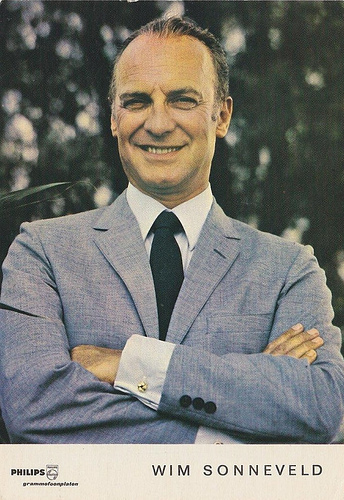
Dutch postcard. Photo: Philips grammofoonplaten. Collection: Gé Joosten.
Rim Ram
Willem Benedictus Augustinus Sonneveld was born in 1917 in Utrecht, the Netherlands, to Gerrit Sonneveld and Geertruida van den Berg. In 1922, at a very young age, Wim lost his mother.
In 1932 he started singing in an amateur choir, the Keep Smiling Singers, after which he teamed up in 1934 with Fons Goossens to form a duo and perform at anniversaries of associations and institutions.
Later that year he met reviewer Huub Janssen and after a journey through France in 1936 they started living together in Amsterdam. In the same year he made his stage debut with Louis Davids in the Hollandse Schouwburg in Amsterdam. He worked during the day as administrator and at evenings he played small roles and sang chansons.
In 1937 he went to France and sang in cabarets of Suzy Solidor and Agnes Capri. After the declaration of war of 1940 he returned to the Netherlands, where he acted in plays and in the revue of Loekie Bouwmeester.
In 1940 he performed in the Theater der Prominenten and at Abraham van der Vies' De Sprookjesspelers. Here he met singer Conny Stuart.
In 1943 he formed his own cabaret group Rim Ram, consisting among others of Conny Stuart, Lia Dorana, Albert Mol, Joop Doderer, Hetty Blok and Emmy Arbous. Between 1943 and 1959 he staged a great number of shows with Rim Ram.
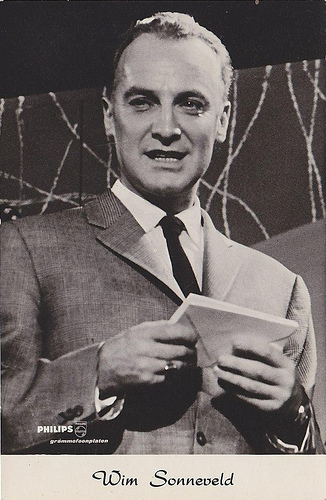
Dutch postcard. Photo: Philips grammofoonplaten. Collection: Gé Joosten.
Silk Stockings
A famous creation of Wim Sonneveld was Willem Parel, son and grandson of a Dutch street organ grinder as well as chairman of the En-pé-gé, the Nederlands Parel Genootschap (the Dutch Parel Association). This character brought him great success first on stage and later on the VARA-radio.
Willem Parel would expose movingly about ‘organ grinding in general and the psychology of the penny cup in particular’. Over time Wim Sonneveld came to hate his creation, but he knew that Willem Parel drew a large audience and he couldn't live from just singing chansons.
In 1955 a film was shot called Het wonderlijke leven van Willem Parel/The Wondrous life of Willem Parel (Gerard Rutten, 1955). Sonneveld appeared as himself and narrated the film, until his 'Willem Parel' steps down from a poster on the dressing room wall and starts scolding his creator for trying to get rid of him.
The film didn't become the enormous success it was expected to be, but American casting agent Mitchell Gertz, saw it and offered Wim a contract in Hollywood. There he played in the TV thriller The Pink Hippopotamus (1956), the musical Silk stockings (Rouben Mamoulian, 1957) as a Russian opposite Fred Astaire, and Wasp End (1957).
Still, Sonneveld soon got homesick and returned to Europe. He admitted to prefer his homegrown audience instead of having to build a whole new one abroad.
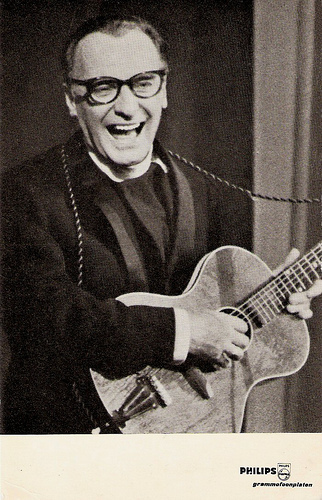
Wim Sonneveld as Frater Venantius. Dutch postcard. Photo: Philips grammofoonplaten.
Friar Venantius
In 1958 Wim Sonneveld made eight TV shows in Great Britain for the BBC and in 1960 he starred as Dr. Higgins in the Dutch stage version of the musical My Fair Lady. With 702 performances, the musical was one of the most successful Dutch stage shows ever.
He then went solo with television shows like Doe es wat, meneer Sonneveld/Do Something, mr. Sonneveld (1962) and Blijf in Holland/Stay in Holland (1963). Wim Sonneveld again took the stage in 1964 with Een avond met Wim Sonneveld/An Evening With Wim Sonneveld.
For the Grand Gala Du Disc he created one of his famous characters, Frater Venantius (Friar Venantius). His record about the friar became a top 10 hit in 1965.
Remarkable were also his guest roles in the legendary TV series Ja zuster, nee zuster/Yes Nurse, No Nurse (1967), written by Annie M.G. Schmidt.
Two of his songs from the series became hit records: De kat van Ome Willem/Uncle Willem’s Cat (1968) and In een rijtuigje/In a Small Carriage (1968) which he sang with Leen Jongewaard.
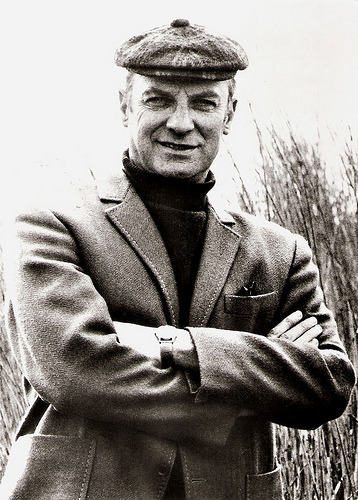
Dutch postcard. Photo: Philips grammofoonplaten.
Going Dutch
He did two more successful theatre shows: the first in 1967 with Ina van Faassen and the last one in 1971 with Willem Nijholt and Corrie van Gorp.
He also made another film, Op de Hollandse toer/Going Dutch (Harry Booth, 1973). Critics were quite harsh in their reviews of this picture and the public stayed away as well. The film was a financial catastrophe and later was even thought lost (but the original negative has survived).
In 1974 Wim Sonneveld died from a heart attack in the VU hospital in Amsterdam. He was only 56.
Even though Wim Sonneveld never publicly stated that he was homosexual, he shared his life only with men, first with Huub Janssen, later with prop designer, text writer and painter Friso Wiegersma whom he had met in 1947 and who created the famous character Nikkelen Nelis for him.
Scene from Het wonderlijke leven van Willem Parel/The Wondrous life of Willem Parel (1955). Wim Sonneveld sings Poen (Dough). Source: Crescendo1950 (YouTube).
Another scene from Het wonderlijke leven van Willem Parel (1955). Wim Sonneveld sings De wonderen zijn de wereld nog niet uit/There Are Still Wonders on Earth. Source: Crescendo 1950 (YouTube).
Wim Sonneveld as Nikkelen Nelis. Source: Kim Lempereur (YouTube).
Sources: Hilde Scholten (Een Leven Lang Theater) (Dutch), Wikipedia, and .

Dutch postcard. Photo: Philips grammofoonplaten. Collection: Gé Joosten.
Rim Ram
Willem Benedictus Augustinus Sonneveld was born in 1917 in Utrecht, the Netherlands, to Gerrit Sonneveld and Geertruida van den Berg. In 1922, at a very young age, Wim lost his mother.
In 1932 he started singing in an amateur choir, the Keep Smiling Singers, after which he teamed up in 1934 with Fons Goossens to form a duo and perform at anniversaries of associations and institutions.
Later that year he met reviewer Huub Janssen and after a journey through France in 1936 they started living together in Amsterdam. In the same year he made his stage debut with Louis Davids in the Hollandse Schouwburg in Amsterdam. He worked during the day as administrator and at evenings he played small roles and sang chansons.
In 1937 he went to France and sang in cabarets of Suzy Solidor and Agnes Capri. After the declaration of war of 1940 he returned to the Netherlands, where he acted in plays and in the revue of Loekie Bouwmeester.
In 1940 he performed in the Theater der Prominenten and at Abraham van der Vies' De Sprookjesspelers. Here he met singer Conny Stuart.
In 1943 he formed his own cabaret group Rim Ram, consisting among others of Conny Stuart, Lia Dorana, Albert Mol, Joop Doderer, Hetty Blok and Emmy Arbous. Between 1943 and 1959 he staged a great number of shows with Rim Ram.

Dutch postcard. Photo: Philips grammofoonplaten. Collection: Gé Joosten.
Silk Stockings
A famous creation of Wim Sonneveld was Willem Parel, son and grandson of a Dutch street organ grinder as well as chairman of the En-pé-gé, the Nederlands Parel Genootschap (the Dutch Parel Association). This character brought him great success first on stage and later on the VARA-radio.
Willem Parel would expose movingly about ‘organ grinding in general and the psychology of the penny cup in particular’. Over time Wim Sonneveld came to hate his creation, but he knew that Willem Parel drew a large audience and he couldn't live from just singing chansons.
In 1955 a film was shot called Het wonderlijke leven van Willem Parel/The Wondrous life of Willem Parel (Gerard Rutten, 1955). Sonneveld appeared as himself and narrated the film, until his 'Willem Parel' steps down from a poster on the dressing room wall and starts scolding his creator for trying to get rid of him.
The film didn't become the enormous success it was expected to be, but American casting agent Mitchell Gertz, saw it and offered Wim a contract in Hollywood. There he played in the TV thriller The Pink Hippopotamus (1956), the musical Silk stockings (Rouben Mamoulian, 1957) as a Russian opposite Fred Astaire, and Wasp End (1957).
Still, Sonneveld soon got homesick and returned to Europe. He admitted to prefer his homegrown audience instead of having to build a whole new one abroad.

Wim Sonneveld as Frater Venantius. Dutch postcard. Photo: Philips grammofoonplaten.
Friar Venantius
In 1958 Wim Sonneveld made eight TV shows in Great Britain for the BBC and in 1960 he starred as Dr. Higgins in the Dutch stage version of the musical My Fair Lady. With 702 performances, the musical was one of the most successful Dutch stage shows ever.
He then went solo with television shows like Doe es wat, meneer Sonneveld/Do Something, mr. Sonneveld (1962) and Blijf in Holland/Stay in Holland (1963). Wim Sonneveld again took the stage in 1964 with Een avond met Wim Sonneveld/An Evening With Wim Sonneveld.
For the Grand Gala Du Disc he created one of his famous characters, Frater Venantius (Friar Venantius). His record about the friar became a top 10 hit in 1965.
Remarkable were also his guest roles in the legendary TV series Ja zuster, nee zuster/Yes Nurse, No Nurse (1967), written by Annie M.G. Schmidt.
Two of his songs from the series became hit records: De kat van Ome Willem/Uncle Willem’s Cat (1968) and In een rijtuigje/In a Small Carriage (1968) which he sang with Leen Jongewaard.

Dutch postcard. Photo: Philips grammofoonplaten.
Going Dutch
He did two more successful theatre shows: the first in 1967 with Ina van Faassen and the last one in 1971 with Willem Nijholt and Corrie van Gorp.
He also made another film, Op de Hollandse toer/Going Dutch (Harry Booth, 1973). Critics were quite harsh in their reviews of this picture and the public stayed away as well. The film was a financial catastrophe and later was even thought lost (but the original negative has survived).
In 1974 Wim Sonneveld died from a heart attack in the VU hospital in Amsterdam. He was only 56.
Even though Wim Sonneveld never publicly stated that he was homosexual, he shared his life only with men, first with Huub Janssen, later with prop designer, text writer and painter Friso Wiegersma whom he had met in 1947 and who created the famous character Nikkelen Nelis for him.
Scene from Het wonderlijke leven van Willem Parel/The Wondrous life of Willem Parel (1955). Wim Sonneveld sings Poen (Dough). Source: Crescendo1950 (YouTube).
Another scene from Het wonderlijke leven van Willem Parel (1955). Wim Sonneveld sings De wonderen zijn de wereld nog niet uit/There Are Still Wonders on Earth. Source: Crescendo 1950 (YouTube).
Wim Sonneveld as Nikkelen Nelis. Source: Kim Lempereur (YouTube).
Sources: Hilde Scholten (Een Leven Lang Theater) (Dutch), Wikipedia, and .
Published on April 13, 2014 23:00
April 12, 2014
Pierre Richard-Willm
Elegant French actor Pierre Richard-Willm (1895-1983) starred in 40 films during the 1930s and the first half of the 1940s. The good-looking jeune premier excelled in the foreign legion melodrama Le Grand Jeu/The Great Game (1934) and as Edmond Dantès in Le Comte de Monte-Cristo/The Count of Monte-Christo (1943).
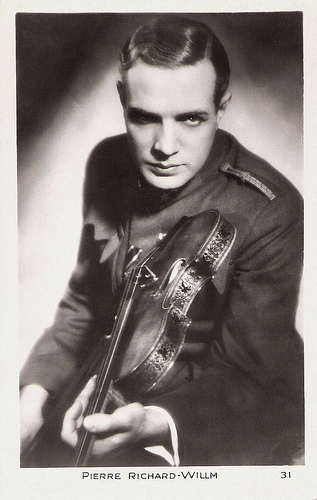
French postcard, no. 31. Photo: publicity still for Stradivarius (Albert Valentin, Géza von Bolváry, 1935).
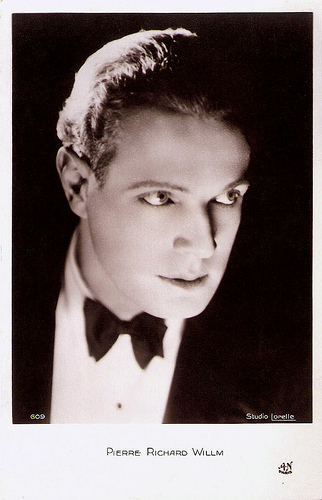
French postcard by A.N., Paris, no. 609. Photo: Studio Lorelle.
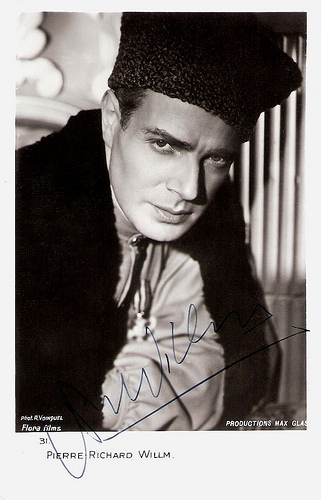
French postcard by Editions Chantal, no. 31. Photo: R. Voinquel / Flora Films / Productions Max Glas.
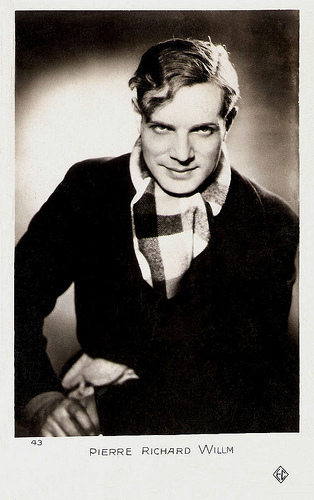
French postcard by EC, no. 43.
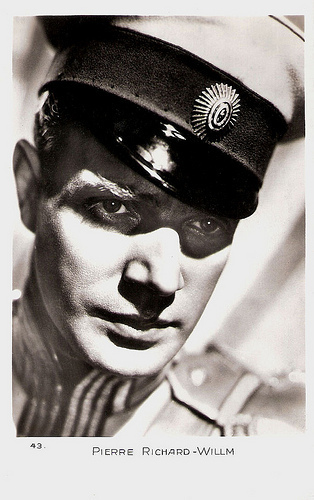
French postcard, no. 43.
Charming Spectators Of All Ages
Pierre Richard-Willm was born as Alexander Pierre Richard in south-western France in the city of Bayonne in 1895. His mother, Elisabeth-Fanny Willm, died at the age of thirty-one, and from 1905 on he was raised by his maternal grandmother in Bordeaux.
He attended the école des Beaux-Arts in Nantes. Theatre was his passion and in 1911 he started as an amateur at the Théâtre du Peuple de Bussang.
In 1916 he joined the army and fought during World War I at Verdun. After the war he became a sculptor, and in 1921 he started playing bit roles on the professional stage.
From 1925 on he worked at the Odeon in Paris in plays like La dame aux camélias under the pseudonym Richard Willm, the combined name of his father and mother.
His film debut as a jeune premier came in the Paramount production Toute sa vie/Sarah and Son (Alberto Cavalcanti, 1930), followed by another film by Alberto Cavalcanti for Paramount, Les Vacances du diable/The Devil's Holiday (1931).
With his elegance and good looks he charmed spectators of all ages. The next years he made dozens of films, including French versions of Ufa productions including Autour d'une enquête/Preliminary Investigation (Pierre Chomette, Robert Siodmak, 1931) starring Annabella , and La fille du régiment/The Daughter of the Regiment (Pierre Billon, Carl Lamac, 1933) starring Anny Ondra .
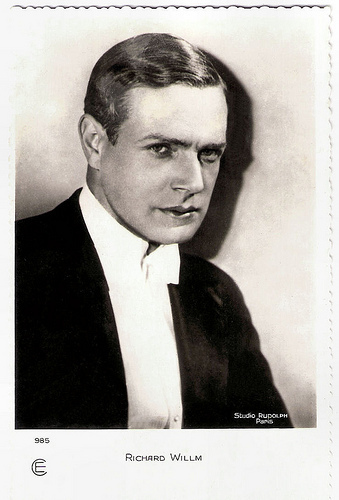
French postcard by EC, no. 985. Photo: Studio Rudolph, Paris.
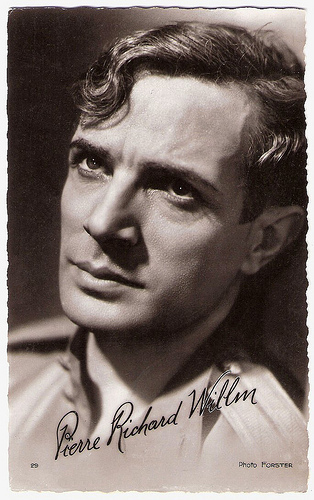
French postcard by Editions et Publications cinematographiques, no. 29. Photo: Forster.
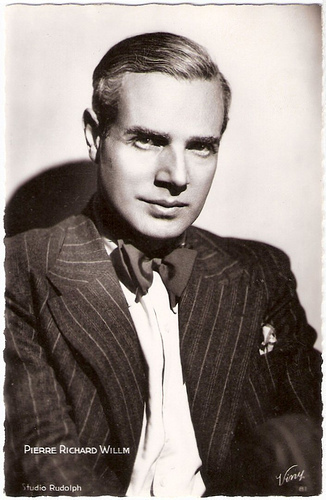
French postcard by Viny, no. 81. Photo: Studio Rudolph.
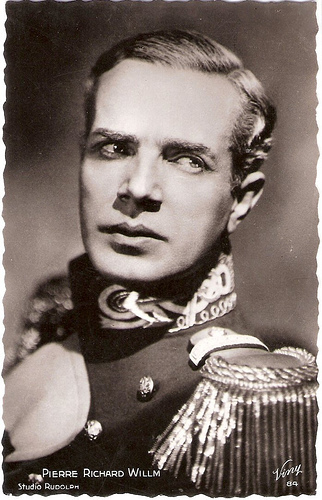
French postcard by Viny, no. 84. Photo: Studio Rudolph.
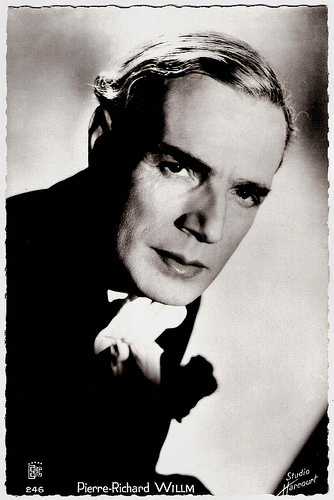
French postcard, no. 134. Photo Studio Harcourt.
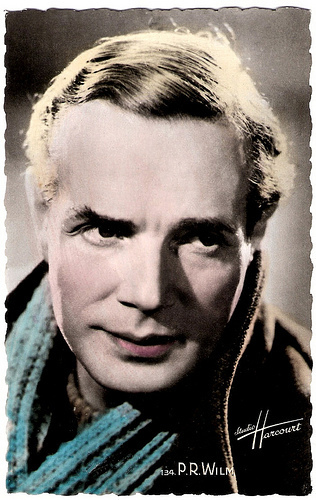
French postcard by S.E.R.P., Paris, no. 134. Photo: Studio Harcourt.
Count of Monte Christo
Pierre Richard-Willm’s breakthrough was the foreign legion melodrama Le Grand Jeu/The Great Game (Jacques Feyder, 1934), in which he starred opposite Charles Vanel and Marie Bell .
In the following years he often played the partner of diva Edwige Feuillère in such films as Stradivarius (Albert Valentin, Géza von Bolváry, 1935), Barcarolle (Gerhard Lamprecht, Roger Le Bon, 1935), La Dame de Malacca/Woman of Malacca (Marc Allégret, 1937) and La Duchesse de Langeais/Wicked Dutchess (Jacques de Baroncelli, 1942).
Famous director Max Ophüls directed him in Yoshiwara (1937) and Werther (1938).
A big hit was Un Carnet de bal/Dance Program (Julien Duvivier, 193) in which Marie Bell stars as a woman who decides to find out about the men (including Pierre Richard-Willm) who once danced with her during a ball that was a turning point in her life.
His most famous role was Edmond Dantès in two episodes of Le Comte de Monte-Cristo/The Count of Monte-Christo (Robert Vernay, 1943) based on the famous novel by Alexandre Dumas père.
He starred as composer Franz Liszt in Rêves d'Amour/Dreams of Love (Christian Stengel, 1942-1947), for which film he also designed the sets.
In 1946 he decided to retire from the cinema and to dedicate himself completely to his beloved Theatre Vosgien.
In 1975 he wrote his memoires, Loin des Étoiles (Far from the stars), in which he wrote that the cinema had only been a nice intermission for him.
Pierre Richard-Willm died in 1983 in Paris.
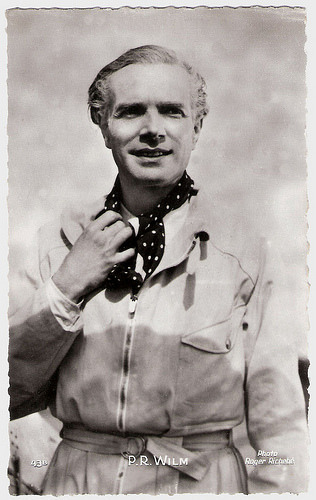
French postcard by Ed. Chantal, Rueil, no. 43B. Photo: Roger Richebé.
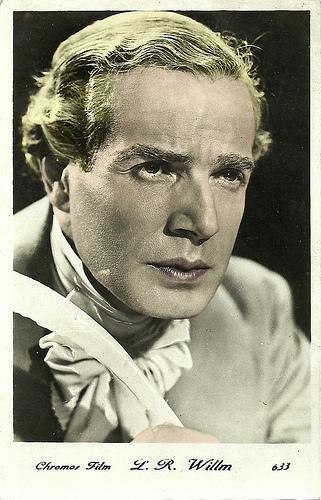
French postcard, no. 633. Photo: Chromos Film.

French postcard by Editions P.I., Paris, no. 20. Photo: Teddy Piaz.
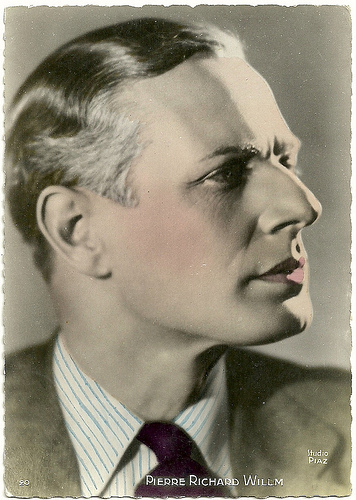
French postcard by O.P., Paris, no. 2. Photo: Studio Piaz.
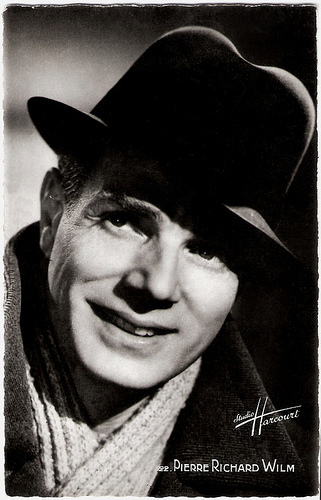
French postcard by S.E.R.P., Paris, no. 22. Photo: Studio Harcourt.
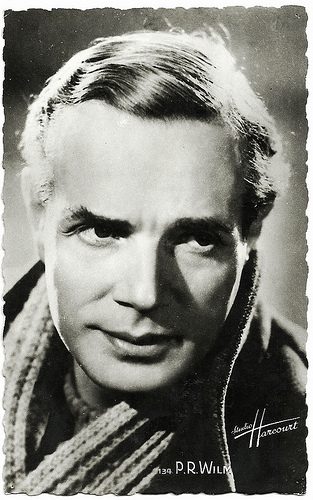
French postcard by EPC, no. 246. Photo: Studio Harcourt.
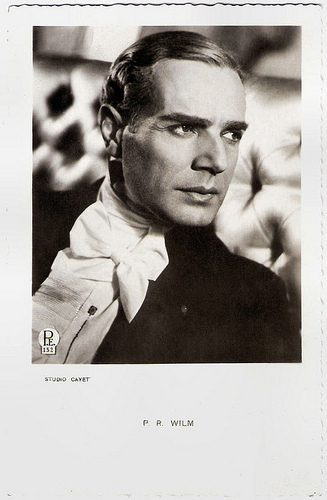
Belgian postcard by P.E. (Photo Édition), no. 152. Photo: Studio Cayet.
Sources: Caroline Hanotte (Cineartistes.com), Franck Richard, Wikipedia and .

French postcard, no. 31. Photo: publicity still for Stradivarius (Albert Valentin, Géza von Bolváry, 1935).

French postcard by A.N., Paris, no. 609. Photo: Studio Lorelle.

French postcard by Editions Chantal, no. 31. Photo: R. Voinquel / Flora Films / Productions Max Glas.

French postcard by EC, no. 43.

French postcard, no. 43.
Charming Spectators Of All Ages
Pierre Richard-Willm was born as Alexander Pierre Richard in south-western France in the city of Bayonne in 1895. His mother, Elisabeth-Fanny Willm, died at the age of thirty-one, and from 1905 on he was raised by his maternal grandmother in Bordeaux.
He attended the école des Beaux-Arts in Nantes. Theatre was his passion and in 1911 he started as an amateur at the Théâtre du Peuple de Bussang.
In 1916 he joined the army and fought during World War I at Verdun. After the war he became a sculptor, and in 1921 he started playing bit roles on the professional stage.
From 1925 on he worked at the Odeon in Paris in plays like La dame aux camélias under the pseudonym Richard Willm, the combined name of his father and mother.
His film debut as a jeune premier came in the Paramount production Toute sa vie/Sarah and Son (Alberto Cavalcanti, 1930), followed by another film by Alberto Cavalcanti for Paramount, Les Vacances du diable/The Devil's Holiday (1931).
With his elegance and good looks he charmed spectators of all ages. The next years he made dozens of films, including French versions of Ufa productions including Autour d'une enquête/Preliminary Investigation (Pierre Chomette, Robert Siodmak, 1931) starring Annabella , and La fille du régiment/The Daughter of the Regiment (Pierre Billon, Carl Lamac, 1933) starring Anny Ondra .

French postcard by EC, no. 985. Photo: Studio Rudolph, Paris.

French postcard by Editions et Publications cinematographiques, no. 29. Photo: Forster.

French postcard by Viny, no. 81. Photo: Studio Rudolph.

French postcard by Viny, no. 84. Photo: Studio Rudolph.

French postcard, no. 134. Photo Studio Harcourt.

French postcard by S.E.R.P., Paris, no. 134. Photo: Studio Harcourt.
Count of Monte Christo
Pierre Richard-Willm’s breakthrough was the foreign legion melodrama Le Grand Jeu/The Great Game (Jacques Feyder, 1934), in which he starred opposite Charles Vanel and Marie Bell .
In the following years he often played the partner of diva Edwige Feuillère in such films as Stradivarius (Albert Valentin, Géza von Bolváry, 1935), Barcarolle (Gerhard Lamprecht, Roger Le Bon, 1935), La Dame de Malacca/Woman of Malacca (Marc Allégret, 1937) and La Duchesse de Langeais/Wicked Dutchess (Jacques de Baroncelli, 1942).
Famous director Max Ophüls directed him in Yoshiwara (1937) and Werther (1938).
A big hit was Un Carnet de bal/Dance Program (Julien Duvivier, 193) in which Marie Bell stars as a woman who decides to find out about the men (including Pierre Richard-Willm) who once danced with her during a ball that was a turning point in her life.
His most famous role was Edmond Dantès in two episodes of Le Comte de Monte-Cristo/The Count of Monte-Christo (Robert Vernay, 1943) based on the famous novel by Alexandre Dumas père.
He starred as composer Franz Liszt in Rêves d'Amour/Dreams of Love (Christian Stengel, 1942-1947), for which film he also designed the sets.
In 1946 he decided to retire from the cinema and to dedicate himself completely to his beloved Theatre Vosgien.
In 1975 he wrote his memoires, Loin des Étoiles (Far from the stars), in which he wrote that the cinema had only been a nice intermission for him.
Pierre Richard-Willm died in 1983 in Paris.

French postcard by Ed. Chantal, Rueil, no. 43B. Photo: Roger Richebé.

French postcard, no. 633. Photo: Chromos Film.

French postcard by Editions P.I., Paris, no. 20. Photo: Teddy Piaz.

French postcard by O.P., Paris, no. 2. Photo: Studio Piaz.

French postcard by S.E.R.P., Paris, no. 22. Photo: Studio Harcourt.

French postcard by EPC, no. 246. Photo: Studio Harcourt.

Belgian postcard by P.E. (Photo Édition), no. 152. Photo: Studio Cayet.
Sources: Caroline Hanotte (Cineartistes.com), Franck Richard, Wikipedia and .
Published on April 12, 2014 23:00
April 11, 2014
Casa Filmului Acin
Behind the Iron Curtain, there used to be an interesting film culture. The cinemas of Poland, Russia, East-Germany, Hungary and Czechoslovakia produced several film classics during the 1950s, 1960s and 1970s that fared very well at international film festivals. East-Germany and Romania were the specialists in film postcards. Last Saturday, we had a post on VEB Progress Filmvertrieb from East-Germany. Today, we present you the wonderful world of Casa Filmului Acin from Romania.

Emmanuelle Béart. Romanian postcard by Casa Filmului Acin, no. 43033.
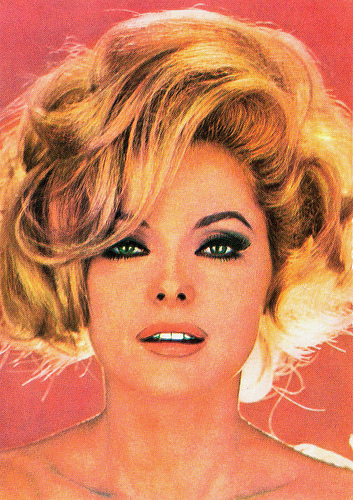
Virna Lisi . Romanian postcard by Casa Filmului Acin. Retail price: 2 Lei. At the backside is written: Sylva Koscina (sic).
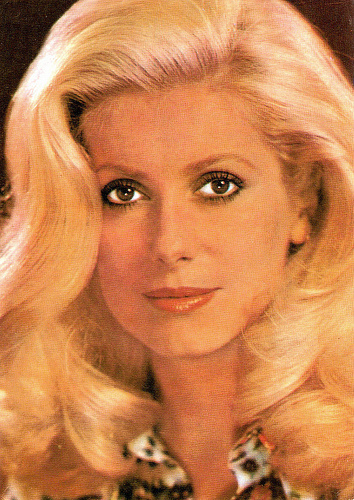
Catherine Deneuve . Romanian postcard by Casa Filmului Acin, no. 568.
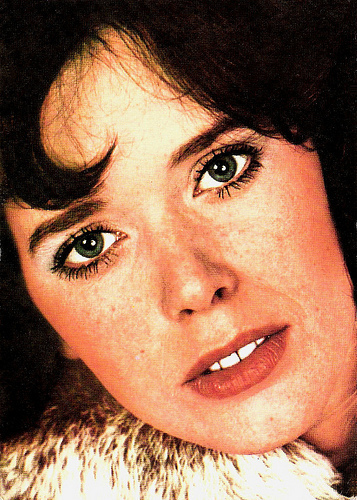
Sylvia Kristel . Romanian postcard by Casa Filmului Acin.
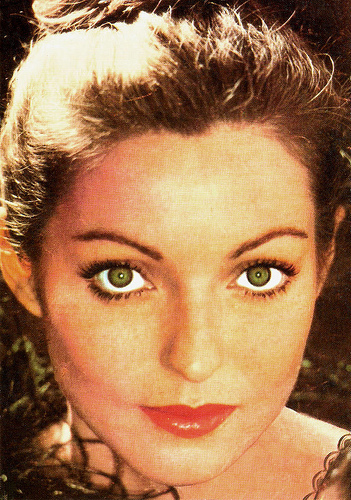
Marie-France Pisier . Romanian postcard by Casa Filmului Acin.
ABBA and more ABBA
Do you feel a bit nostalgic and need a glimpse of the 1960s, 1970s and 1980s? Surf to Flickr's new group, Casa Filmului Acin (Film House Acin).
You'll find hundreds of Romanian vintage postcards of pop artists, TV heroes and film stars, dating from the 1960s till 1989, the year Nicolae Ceaușescu's regime ended.
See ABBA, Boney M, Amanda Lear and more ABBA there - in their most eye-blinding, glittering seventies outfits.
Acin published several cards of Clint Eastwood in the Spaghetti Westerns by Sergio Leone, Ali MacGraw and Ryan O'Neal in Love Story (Arthur Hiller, 1970) and one of Sharon Tate, Patty Duke and Barbara Parkins in Valley of the Dolls (Mark Robson, 1967).
American TV classics like McCloud, Charlie's Angels, Columbo and Dynasty are present as well, and the sex symbol of the early 1970s, Raquel Welch.
All these postcards were produced behind the Iron Curtain in communist Romania, and now these colourful and a bit odd postcards finally reach the rest of the world.
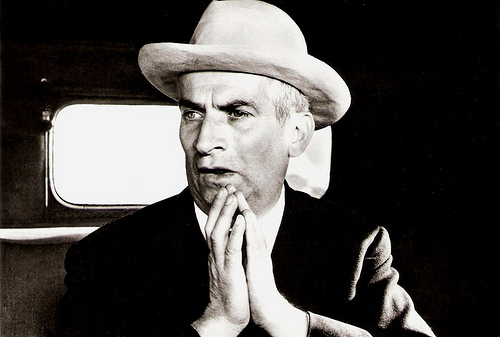
Louis de Funès . Romanian postcard by Casa Filmului Acin, no. 181. Retail price: 1,50 Lei.
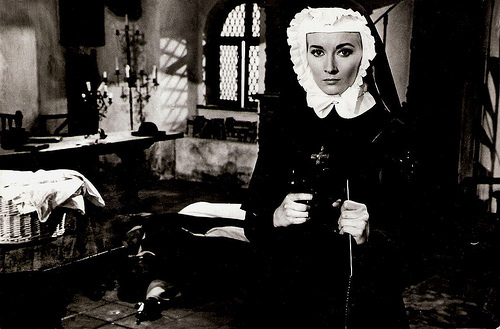
Daniela Bianchi. Romanian postcard by Casa Filmului Acin. Photo: Publicity still for Missione speciale Lady Chaplin/Operation Lady Chaplin (Alberto De Martino, Sergio Grieco, 1966).
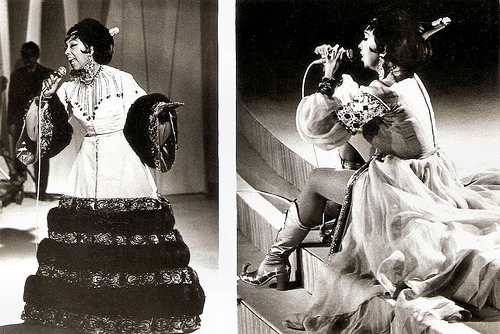
Josephine Baker . Romanian postcard by Casa Filmului Acin, no. 5293, 1970.

Robert Hossein . Romanian postcard by Casa Filmului Acin. Publicity still for Indomptable Angelique/Untamable Angelique (Bernard Borderie, 1967).
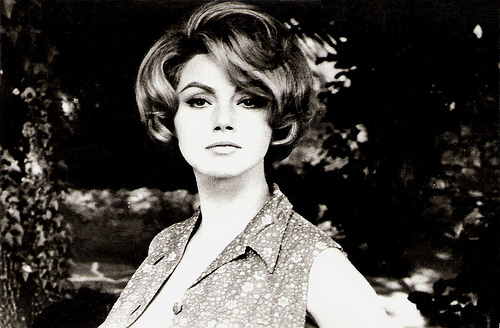
Sylva Koscina . Romanian postcard by Casa Filmului Acin, no. 217. Retail price: 1,50 Lei.
Immensely Popular
The Acin group at Flickr was founded by postcard collector Veronique3 from Bucharest.
Earlier she wrote at EFSP : "In the past, it used to be difficult to find these cards in my country. People bought them before we knew that they had arrived at the post office. A cousin of mine worked for the post office, so I could start my collection thanks to her."
Producer of the Acin cards was the C.P.C.S., a state owned company.
The eldest Acin cards I could trace must be from the mid-1960s, when Ceaușescu came to power.
These black and white postcards contain stills of sixties phenomena like the Eurospy films, Michèle Mercier and Robert Hossein in the sensual Angélique romances and the hilarious Louis de Funès farces.
The cards were cheaply made and cost only 1.50 lei (ca. 0.33 euro). Later, the Retail price of the colour cards - printed on thin paper and the tekst on the flip side is in blue ink - was 2 Lei (ca. 0.45 euro).
The colour procedure was not always optimal, but the result often has a special charm.
Veronique writes that the cards were also for sale at the news stands in Romania, but also at the kiosks the Acin cards were always quickly sold out.
You had to have a contact at C.P.C.S. or at one of the retail points to be able to collect them all.
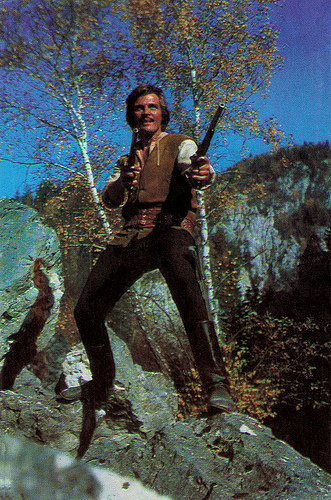
Florin Piersic . Romanian postcard by Casa Filmului Acin.
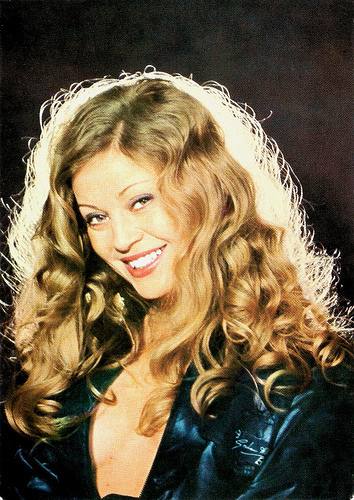
Anna Széles . Romanian postcard by Casa Filmului Acin.
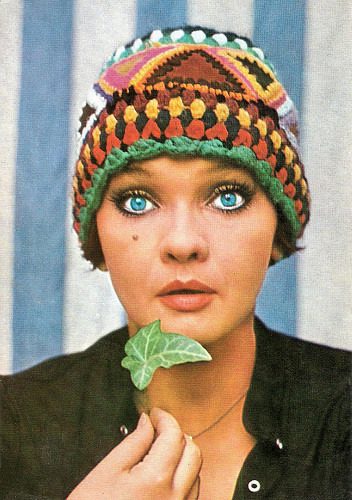
Margareta Pislaru. Romanian postcard by Casa Filmului Acin.
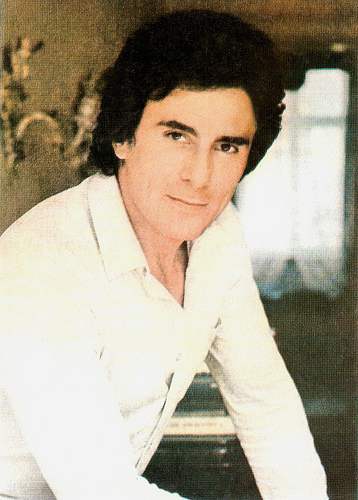
Gojko Mitic . Romanian postcard by Casa Filmului Acin, no. 43079.
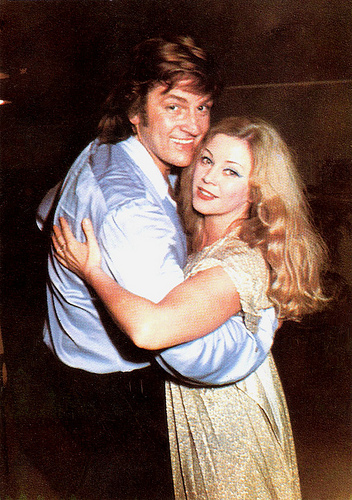
Florin Piersic , Anna Széles . Romanian postcard by Casa Filmului Acin, no. 33 150.
Often Very Beautiful
Today the postcards of Casa Filmului Acin are vintage and can be bought at sites on the net. The prices are now a bit higher than the 2 Lei they used to cost forty years ago, but still affordable.
Many stars on the Acin postcards are of course Romanian. The two major pop divas were Angela Similea and Margareta Pislaru, who both also appeared in several films.
Then there was Florin Piersic , one of the most renowned Romanian film actors and a monster sacré of the National Theatre in Bucharest. During the Ceauşescu era he appeared in more than forty films, in which he often depicted heroic, masculine characters.
He was married for a while to the ravishing Anna Széles , who appeared as a princess in the popular East-European fairy tales of the 1970s.
Besides giving this unique view at the Romanian film and music culture of the Ceauşescu period, I think it is interesting that Acin continued to produce film star postcards in a period many other European publishers had stopped to do so.
Acin published dozens of postcards of French and Italian stars of the 1970s and 1980s, and their photos are often incredibly beautiful.
Who else published postcards of such actors as Dominique Sanda , Sylvia Kristel or Marc Porel ?
Only Casa Filmului Acin!
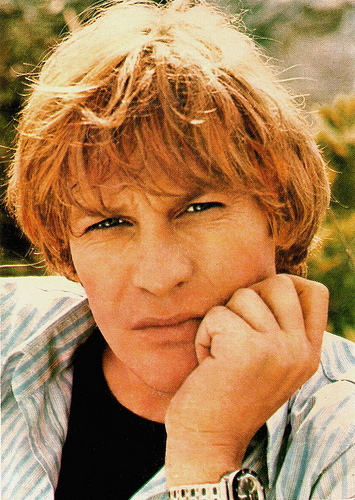
Helmut Berger . Romanian postcard by Casa Filmului Acin.
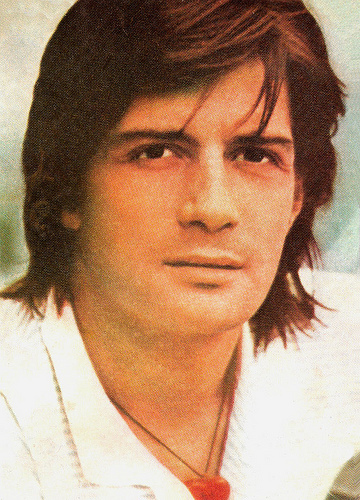
Marc Porel . Romanian postcard by Casa Filmului Acin, no. 33132.
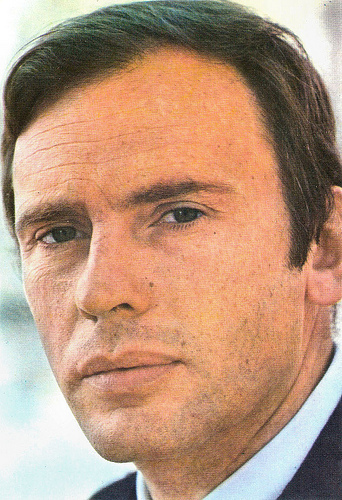
Jean-Louis Trintignant . Romanian postcard by Casa Filmului Acin.
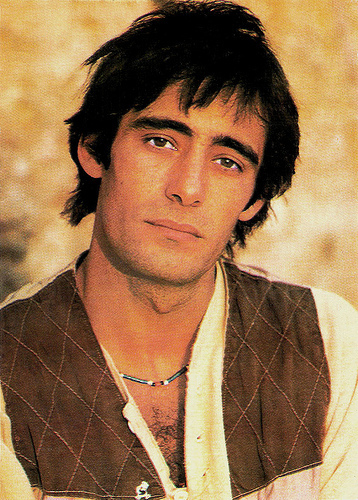
Gérard Lanvin . Romanian postcard by Casa Filmului Acin.

Francis Huster . Romanian postcard by Casa Filmului Acin.
Source: Veronique3 (Flickr).

Emmanuelle Béart. Romanian postcard by Casa Filmului Acin, no. 43033.

Virna Lisi . Romanian postcard by Casa Filmului Acin. Retail price: 2 Lei. At the backside is written: Sylva Koscina (sic).

Catherine Deneuve . Romanian postcard by Casa Filmului Acin, no. 568.

Sylvia Kristel . Romanian postcard by Casa Filmului Acin.

Marie-France Pisier . Romanian postcard by Casa Filmului Acin.
ABBA and more ABBA
Do you feel a bit nostalgic and need a glimpse of the 1960s, 1970s and 1980s? Surf to Flickr's new group, Casa Filmului Acin (Film House Acin).
You'll find hundreds of Romanian vintage postcards of pop artists, TV heroes and film stars, dating from the 1960s till 1989, the year Nicolae Ceaușescu's regime ended.
See ABBA, Boney M, Amanda Lear and more ABBA there - in their most eye-blinding, glittering seventies outfits.
Acin published several cards of Clint Eastwood in the Spaghetti Westerns by Sergio Leone, Ali MacGraw and Ryan O'Neal in Love Story (Arthur Hiller, 1970) and one of Sharon Tate, Patty Duke and Barbara Parkins in Valley of the Dolls (Mark Robson, 1967).
American TV classics like McCloud, Charlie's Angels, Columbo and Dynasty are present as well, and the sex symbol of the early 1970s, Raquel Welch.
All these postcards were produced behind the Iron Curtain in communist Romania, and now these colourful and a bit odd postcards finally reach the rest of the world.

Louis de Funès . Romanian postcard by Casa Filmului Acin, no. 181. Retail price: 1,50 Lei.

Daniela Bianchi. Romanian postcard by Casa Filmului Acin. Photo: Publicity still for Missione speciale Lady Chaplin/Operation Lady Chaplin (Alberto De Martino, Sergio Grieco, 1966).

Josephine Baker . Romanian postcard by Casa Filmului Acin, no. 5293, 1970.

Robert Hossein . Romanian postcard by Casa Filmului Acin. Publicity still for Indomptable Angelique/Untamable Angelique (Bernard Borderie, 1967).

Sylva Koscina . Romanian postcard by Casa Filmului Acin, no. 217. Retail price: 1,50 Lei.
Immensely Popular
The Acin group at Flickr was founded by postcard collector Veronique3 from Bucharest.
Earlier she wrote at EFSP : "In the past, it used to be difficult to find these cards in my country. People bought them before we knew that they had arrived at the post office. A cousin of mine worked for the post office, so I could start my collection thanks to her."
Producer of the Acin cards was the C.P.C.S., a state owned company.
The eldest Acin cards I could trace must be from the mid-1960s, when Ceaușescu came to power.
These black and white postcards contain stills of sixties phenomena like the Eurospy films, Michèle Mercier and Robert Hossein in the sensual Angélique romances and the hilarious Louis de Funès farces.
The cards were cheaply made and cost only 1.50 lei (ca. 0.33 euro). Later, the Retail price of the colour cards - printed on thin paper and the tekst on the flip side is in blue ink - was 2 Lei (ca. 0.45 euro).
The colour procedure was not always optimal, but the result often has a special charm.
Veronique writes that the cards were also for sale at the news stands in Romania, but also at the kiosks the Acin cards were always quickly sold out.
You had to have a contact at C.P.C.S. or at one of the retail points to be able to collect them all.

Florin Piersic . Romanian postcard by Casa Filmului Acin.

Anna Széles . Romanian postcard by Casa Filmului Acin.

Margareta Pislaru. Romanian postcard by Casa Filmului Acin.

Gojko Mitic . Romanian postcard by Casa Filmului Acin, no. 43079.

Florin Piersic , Anna Széles . Romanian postcard by Casa Filmului Acin, no. 33 150.
Often Very Beautiful
Today the postcards of Casa Filmului Acin are vintage and can be bought at sites on the net. The prices are now a bit higher than the 2 Lei they used to cost forty years ago, but still affordable.
Many stars on the Acin postcards are of course Romanian. The two major pop divas were Angela Similea and Margareta Pislaru, who both also appeared in several films.
Then there was Florin Piersic , one of the most renowned Romanian film actors and a monster sacré of the National Theatre in Bucharest. During the Ceauşescu era he appeared in more than forty films, in which he often depicted heroic, masculine characters.
He was married for a while to the ravishing Anna Széles , who appeared as a princess in the popular East-European fairy tales of the 1970s.
Besides giving this unique view at the Romanian film and music culture of the Ceauşescu period, I think it is interesting that Acin continued to produce film star postcards in a period many other European publishers had stopped to do so.
Acin published dozens of postcards of French and Italian stars of the 1970s and 1980s, and their photos are often incredibly beautiful.
Who else published postcards of such actors as Dominique Sanda , Sylvia Kristel or Marc Porel ?
Only Casa Filmului Acin!

Helmut Berger . Romanian postcard by Casa Filmului Acin.

Marc Porel . Romanian postcard by Casa Filmului Acin, no. 33132.

Jean-Louis Trintignant . Romanian postcard by Casa Filmului Acin.

Gérard Lanvin . Romanian postcard by Casa Filmului Acin.

Francis Huster . Romanian postcard by Casa Filmului Acin.
Source: Veronique3 (Flickr).
Published on April 11, 2014 23:00
April 10, 2014
John Martin Harvey
British actor-manager Sir John Martin Harvey (1863-1944) was one of the last great romantic actors of the English theatre. His most famous play was The Only Way (1899), an adaptation of Charles Dickens' A Tale of Two Cities. 25 years later, he also featured in the film version, as well as in a few other silent and sound films.
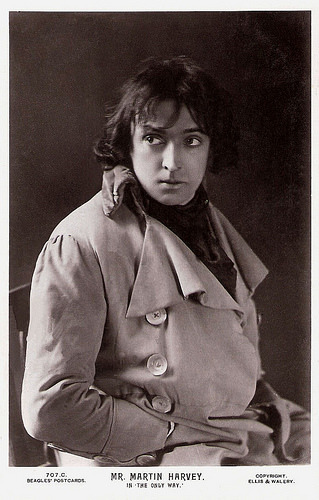
British postcard by Beagles Postcards, no. 707 C. Photo: Ellis & Walery. Publicity still for the stage play The Only Way.
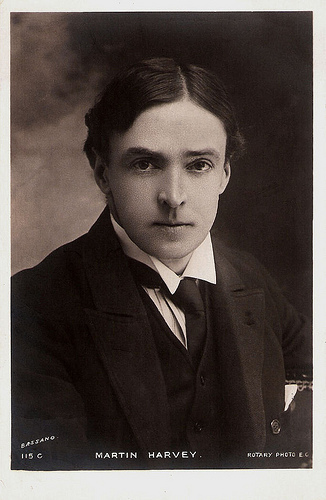
British postcard by Rotary Photo E.C., no. 115 C. Photo: Bassano.
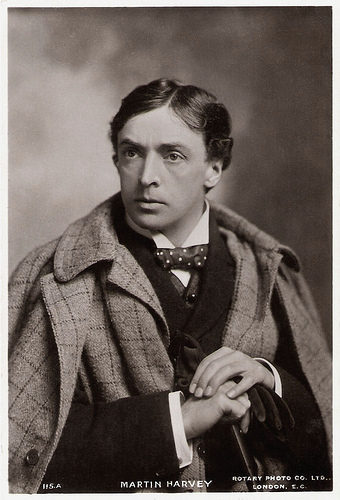
British postcard by Rotary Photo Co. Ltd., London, no. 115.A.
Summer ToursJohn Martin Harvey was born in Wivenhoe, Essex, in 1863. He was the son of John Harvey, a yacht-designer and shipbuilder, and Margaret Diana Mary Goyder.
He was educated at the Old Grammar School in Paisley and the King’s College School in London. His father expected him to follow his own profession, but Martin Harvey had his sights set on the stage.
One of his father's clients was the dramatist W. S. Gilbert, and it was through Gilbert that young 'Jack' Martin Harvey met his first teacher, John Ryder. At the age of 18 he made his first public appearance at the Court Theatre in London in the play To Parents and Guardians in 1881.
A year later he joined Sir Henry Irving 's Lyceum Theatre company. His first role was a non-speaking part in Much Ado About Nothing.
He remained there for 14 years, playing minor parts in London but leading parts during summer tours in such plays as Lady of Lyons, Othello and The Corsican Brothers. He also travelled four times with the company to the United States.
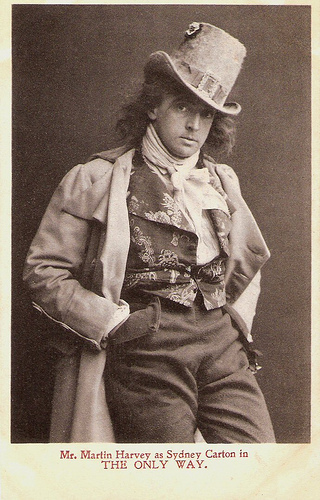
British postcard by the London Stereoscopic Company. Photo: publicity still for The Only Way.
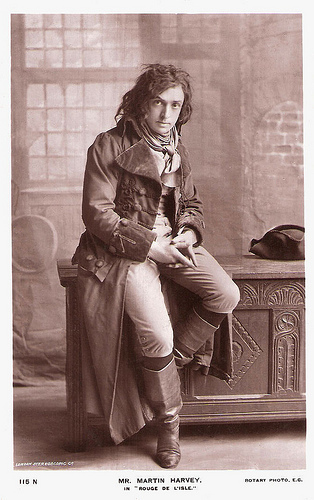
British postcard by Rotary, no. 115 N. Photo: London Stereoscopic Co. Still for the play Rouget de l'Isle by Freeman Wills and Fitzmaurice King. Martin Harvey performed the play about the composer of the French National Anthem, La Marseillaise, at the Prince of Wales Theatre, London, in May 1900.
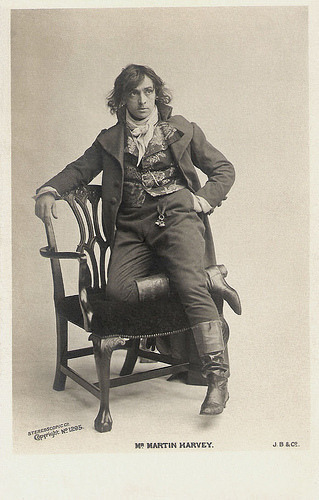
British postcard by J. Beagles & Co. Ltd., London, no. 1295. Photo: The Stereoscopic Co.
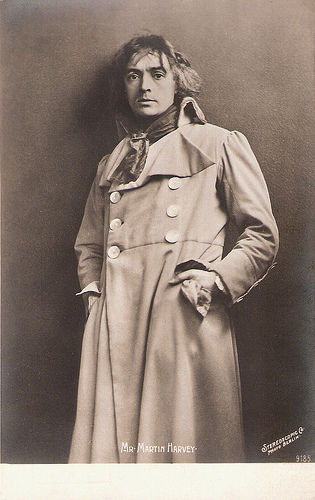
British Rotophot postcard by J. Beagles & Co, London, no. 9185. Photo: Stereoscopic Co., Berlin.
The Only WayMartin Harvey's greatest success came in 1899 when he took over the management of the Lyceum. He excelled in the lead role of Sydney Carton in The Only Way, and his wife, Nina de Silva, played Mimi. She had suggested, planned, and named the play, an adaptation of Charles Dickens' A Tale of Two Cities, but the playwrights were two Irish clergymen, Freeman Wills and Frederick Langbridge.
Harvey’s other successes included Pelleas in Maeterlinck's Pelleas and Melisande (1898, 1900, 1911), with Mrs Patrick Campbell as Melisande and incidental music written for the production by Gabriel Fauré; and Hamlet (1904).
After Sir Henry Irving's death in 1905, Martin Harvey continued to revive his old manager's plays, often using Irving's own props which he had bought. These plays included The Bells and The Lyons Mail.
He did many tours in both Great Britain and North America. His success was always greater in Canada than in the United States, and greater outside London than in the capital.
His later successes included A Cigarette-maker's Romance, Bernard Shaw's The Devil's Disciple, Maeterlinck's The Burgomaster of Stilemonde, Richard III, and The Taming of the Shrew.
One of his finest performances was in 1912 as the protagonist in Max Reinhardt’s Covent Garden production of Oedipus Rex in London.
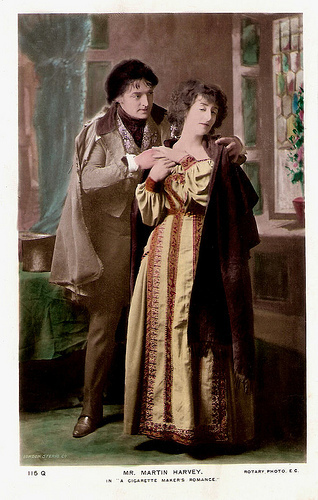
British postcard by Rotary, no. 115 Q. Photo: London Stereoscopic Co. Still for the stage play A Cigarette Maker's Romance, based on the 1890 novel by Francis Marion Crawford. Martin Harvey performed Count Skariatine in this successful play from 1901 till 1939. It was also filmed with him in the lead, A Cigarette-Maker's Romance (Frank Wilson, 1913).
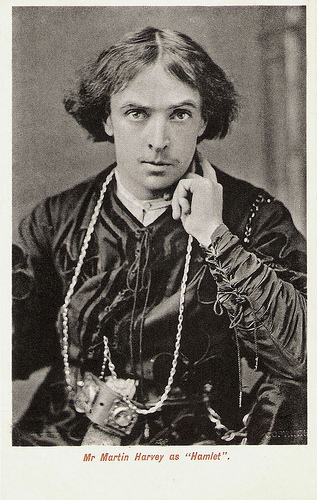
British postcard. Photo: publicity still for a stage production of Hamlet (1904).
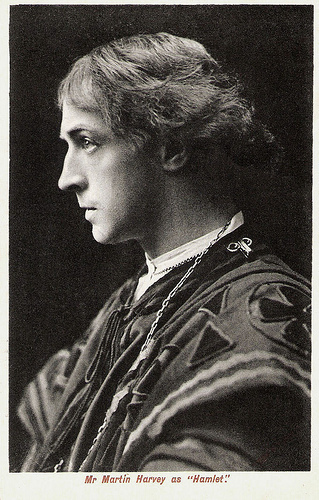
British postcard. Photo: publicity still for a stage production of Hamlet (1904).
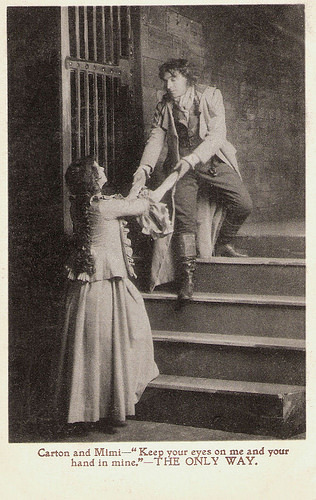
British postcard by London Stereoscopic Company c series. Photo: publicity still for the stage play The Only Way. In 1899, The Only Way, an adaptation of Charles Dickens's A Tale of Two Cities that proved a phenomenal success, registering over 5000 performances over forty years and guaranteeing Harvey's financial security.
Red Feather John Martin Harvey also appeared in some short silent films like A Cigarette-Maker's Romance (Frank Wilson, 1913) and The Broken Melody (Cavendish Morton, 1916).
During the First World War he delivered a large number of recruiting lectures on Sunday evenings in leading theatres throughout the United Kingdom, beginning in September 1914. By collections made there and elsewhere, he raised sums for the British Red Cross, and for wounded soldiers, nurses and other sufferers by the war, - amounting in all to about 25,000 pound.
He also appeared in the film version of The Only Way (Herbert Wilcox, 1925), again as Sydney Carton. This was the first 10,000 foot film made in Great Britain. There were numerous tinted sections, and the final scene (where Carton goes to the guillotine) was tinted in pink.
By the time he retired, Martin Harvey claimed to have performed The Only Way more than 3,000 times, though this would not have been possible in reality.
Other films he appeared in during the 1920s were The Breed of the Treshams (Kenelm Foss, 1920) starring Mary Odette, and The Burgomaster of Stilemonde (George J. Banfield, 1929) with Fern Andra .
His final film was the sound film The Lyons Mail (Arthur Maude, 1931), a mystery-adventure based on a play by Charles Reade.
In 1889 he had married Angelita Helena Maria de Silva Ferro, daughter of a Chilean consul and a fellow actor in Irving's company. They had two children, Muriel Martin-Harvey and Michael Martin-Harvey, both successful actors.
One of the earliest advocates of a National Theatre, he was made Knight Bachelor of the Order of the British Empire in 1921 for his services to drama. After his knighthood he was known as Sir John Martin-Harvey. In 1924, he was made a Chief of the Sarcee tribes of North-West America, under the name Ta-Decasze (Red Feather).
His Autobiography appeared in 1933, simply titled The autobiography of Sir John Martin-Harvey. In 1944, John Martin Harvey died at his home in East Sheen, Surrey, aged 80.
British postcard. Photo: Ellis & Walery. Publicity photo for a stage production of The Breed of the Treshams. John Martin Harvey played Reresby 'the Rat' in many stage productions between 1903 and 1934 as well as in the film The Breed of the Treshams (Kenelm Foss, 1920) with Mary Odette.
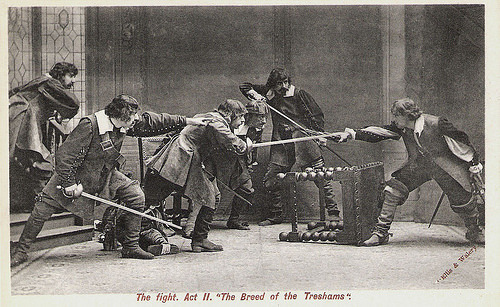
British postcard by the London Stereoscopic Company. Sent by mail in 1906. Photo: publicity still for the stage play The Breed of the Treshams.
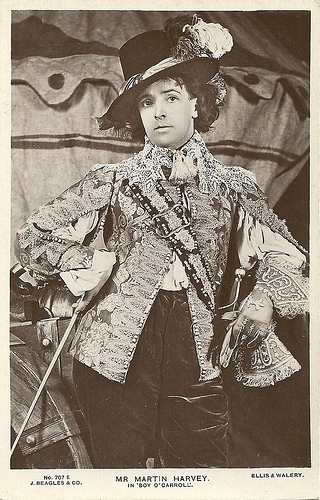
British postcard by J. Beagles & Co., no. 707. Photo: E. Ellis & Walery. Martin Harvey in Boy O'Carroll, a periode piece play by Beulah Marie Dix and G. Sutherland, which was performed at the London Imperial Theatre in May-June 1906. Harvey's co-star in the play was his wife Nina de Silva.
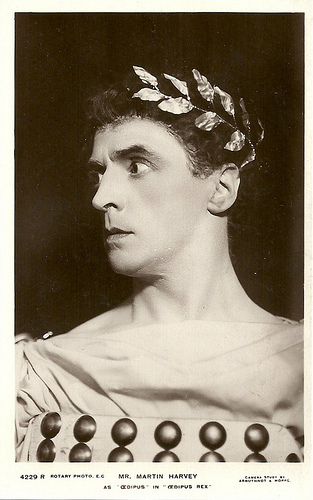
British postcard by Rotary Photo, E.C., no. 4229 R. Camera study by Arbuthnot & Hoppe. Martin Harvey as Oedipus in Oedipus Rex, staged in Covent Garden, London and opening January 1912. It was produced by Max Reinhardt and based on an adaptation of Sophocles' play by Gilbert Murray. Previously, Reinhardt had already staged a - successful - German version by Hugo von Hoffmansthal, opening in Vienna 1910. Writer W.B. Yeats saw the London production and called it the most imaginative production of a play he ever saw.
Sources: Iain MacFarlaine (Find A Grave Memorial), The Glasgow Herald, Chris Goddard (Webrarian.co), Encyclopedia Britannica, Wikipedia, and .

British postcard by Beagles Postcards, no. 707 C. Photo: Ellis & Walery. Publicity still for the stage play The Only Way.

British postcard by Rotary Photo E.C., no. 115 C. Photo: Bassano.

British postcard by Rotary Photo Co. Ltd., London, no. 115.A.
Summer ToursJohn Martin Harvey was born in Wivenhoe, Essex, in 1863. He was the son of John Harvey, a yacht-designer and shipbuilder, and Margaret Diana Mary Goyder.
He was educated at the Old Grammar School in Paisley and the King’s College School in London. His father expected him to follow his own profession, but Martin Harvey had his sights set on the stage.
One of his father's clients was the dramatist W. S. Gilbert, and it was through Gilbert that young 'Jack' Martin Harvey met his first teacher, John Ryder. At the age of 18 he made his first public appearance at the Court Theatre in London in the play To Parents and Guardians in 1881.
A year later he joined Sir Henry Irving 's Lyceum Theatre company. His first role was a non-speaking part in Much Ado About Nothing.
He remained there for 14 years, playing minor parts in London but leading parts during summer tours in such plays as Lady of Lyons, Othello and The Corsican Brothers. He also travelled four times with the company to the United States.

British postcard by the London Stereoscopic Company. Photo: publicity still for The Only Way.

British postcard by Rotary, no. 115 N. Photo: London Stereoscopic Co. Still for the play Rouget de l'Isle by Freeman Wills and Fitzmaurice King. Martin Harvey performed the play about the composer of the French National Anthem, La Marseillaise, at the Prince of Wales Theatre, London, in May 1900.

British postcard by J. Beagles & Co. Ltd., London, no. 1295. Photo: The Stereoscopic Co.

British Rotophot postcard by J. Beagles & Co, London, no. 9185. Photo: Stereoscopic Co., Berlin.
The Only WayMartin Harvey's greatest success came in 1899 when he took over the management of the Lyceum. He excelled in the lead role of Sydney Carton in The Only Way, and his wife, Nina de Silva, played Mimi. She had suggested, planned, and named the play, an adaptation of Charles Dickens' A Tale of Two Cities, but the playwrights were two Irish clergymen, Freeman Wills and Frederick Langbridge.
Harvey’s other successes included Pelleas in Maeterlinck's Pelleas and Melisande (1898, 1900, 1911), with Mrs Patrick Campbell as Melisande and incidental music written for the production by Gabriel Fauré; and Hamlet (1904).
After Sir Henry Irving's death in 1905, Martin Harvey continued to revive his old manager's plays, often using Irving's own props which he had bought. These plays included The Bells and The Lyons Mail.
He did many tours in both Great Britain and North America. His success was always greater in Canada than in the United States, and greater outside London than in the capital.
His later successes included A Cigarette-maker's Romance, Bernard Shaw's The Devil's Disciple, Maeterlinck's The Burgomaster of Stilemonde, Richard III, and The Taming of the Shrew.
One of his finest performances was in 1912 as the protagonist in Max Reinhardt’s Covent Garden production of Oedipus Rex in London.

British postcard by Rotary, no. 115 Q. Photo: London Stereoscopic Co. Still for the stage play A Cigarette Maker's Romance, based on the 1890 novel by Francis Marion Crawford. Martin Harvey performed Count Skariatine in this successful play from 1901 till 1939. It was also filmed with him in the lead, A Cigarette-Maker's Romance (Frank Wilson, 1913).

British postcard. Photo: publicity still for a stage production of Hamlet (1904).

British postcard. Photo: publicity still for a stage production of Hamlet (1904).

British postcard by London Stereoscopic Company c series. Photo: publicity still for the stage play The Only Way. In 1899, The Only Way, an adaptation of Charles Dickens's A Tale of Two Cities that proved a phenomenal success, registering over 5000 performances over forty years and guaranteeing Harvey's financial security.
Red Feather John Martin Harvey also appeared in some short silent films like A Cigarette-Maker's Romance (Frank Wilson, 1913) and The Broken Melody (Cavendish Morton, 1916).
During the First World War he delivered a large number of recruiting lectures on Sunday evenings in leading theatres throughout the United Kingdom, beginning in September 1914. By collections made there and elsewhere, he raised sums for the British Red Cross, and for wounded soldiers, nurses and other sufferers by the war, - amounting in all to about 25,000 pound.
He also appeared in the film version of The Only Way (Herbert Wilcox, 1925), again as Sydney Carton. This was the first 10,000 foot film made in Great Britain. There were numerous tinted sections, and the final scene (where Carton goes to the guillotine) was tinted in pink.
By the time he retired, Martin Harvey claimed to have performed The Only Way more than 3,000 times, though this would not have been possible in reality.
Other films he appeared in during the 1920s were The Breed of the Treshams (Kenelm Foss, 1920) starring Mary Odette, and The Burgomaster of Stilemonde (George J. Banfield, 1929) with Fern Andra .
His final film was the sound film The Lyons Mail (Arthur Maude, 1931), a mystery-adventure based on a play by Charles Reade.
In 1889 he had married Angelita Helena Maria de Silva Ferro, daughter of a Chilean consul and a fellow actor in Irving's company. They had two children, Muriel Martin-Harvey and Michael Martin-Harvey, both successful actors.
One of the earliest advocates of a National Theatre, he was made Knight Bachelor of the Order of the British Empire in 1921 for his services to drama. After his knighthood he was known as Sir John Martin-Harvey. In 1924, he was made a Chief of the Sarcee tribes of North-West America, under the name Ta-Decasze (Red Feather).
His Autobiography appeared in 1933, simply titled The autobiography of Sir John Martin-Harvey. In 1944, John Martin Harvey died at his home in East Sheen, Surrey, aged 80.
British postcard. Photo: Ellis & Walery. Publicity photo for a stage production of The Breed of the Treshams. John Martin Harvey played Reresby 'the Rat' in many stage productions between 1903 and 1934 as well as in the film The Breed of the Treshams (Kenelm Foss, 1920) with Mary Odette.

British postcard by the London Stereoscopic Company. Sent by mail in 1906. Photo: publicity still for the stage play The Breed of the Treshams.

British postcard by J. Beagles & Co., no. 707. Photo: E. Ellis & Walery. Martin Harvey in Boy O'Carroll, a periode piece play by Beulah Marie Dix and G. Sutherland, which was performed at the London Imperial Theatre in May-June 1906. Harvey's co-star in the play was his wife Nina de Silva.

British postcard by Rotary Photo, E.C., no. 4229 R. Camera study by Arbuthnot & Hoppe. Martin Harvey as Oedipus in Oedipus Rex, staged in Covent Garden, London and opening January 1912. It was produced by Max Reinhardt and based on an adaptation of Sophocles' play by Gilbert Murray. Previously, Reinhardt had already staged a - successful - German version by Hugo von Hoffmansthal, opening in Vienna 1910. Writer W.B. Yeats saw the London production and called it the most imaginative production of a play he ever saw.
Sources: Iain MacFarlaine (Find A Grave Memorial), The Glasgow Herald, Chris Goddard (Webrarian.co), Encyclopedia Britannica, Wikipedia, and .
Published on April 10, 2014 23:00
April 9, 2014
François Périer
François Périer (1919-2002) was one of France's most beloved performers. This versatile and charming actor was prominent in the theatre and made 117 film and TV appearances between 1938 and 1996.
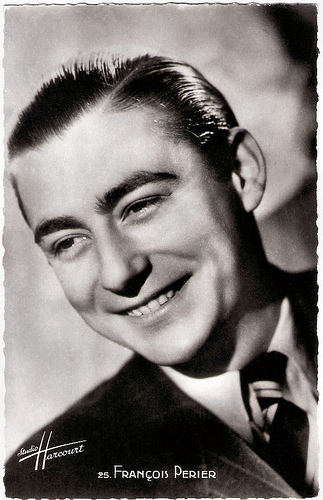
French postcard by S.E.R.P., Paris, no. 25. Photo: Studio Harcourt.
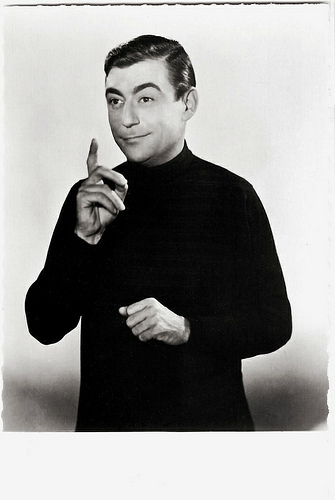
French postcard by Editions P.I., Paris, offered by Les Carbones Korès Carboplane, no. 968.
Fresh-faced, Impudent Adolescent Charm
François Périer was born Francois Marie Gabriel Pillu in Paris, in 1919. His father managed a wine shop.
At age 14, while he was still a pupil at the Lycée Janson-de-Sully, he started studying acting at the Cours René Simon. He got an audition with no less than the legendary actor Louis Jouvet . Jouvet subsequently helped him enter the Conservatoire.
He started his career at the theatre and at the age of 19, he already became a star.
In his obituary in The Independent, James Kirkup wrote about Périer: “Though he was by no means possessed of classic good looks, his fresh-faced, impudent adolescent charm attracted favourable notice when he appeared in Claude-André Puget's delightful comedy of young love Les Jours heureux (Happy Days), a success that kicked off his career with 500 performances and assured his acting future”.
Périer appeared the following decades in all kinds of plays, from the very highest intellectual dramas to the lightest of satirical intrigues. He could illuminate difficult roles and transform a nondescript drama by sheer force of talent, technique and charm.
Among his most notable stage roles was that of Hugo in the first production of Jean-Paul Sartre's Les Mains Sales in 1948. Sartre was his second great idol and Périer also appeared in Sartre's Le Diable et le Bon Dieu (1948), which was revived in 1968 and 1970 on the Théâtre du Chaillot's vast stage.
Later stage triumphs in Sartre plays included his appearance in Les Séquestrés d'Altona (The Condemned of Altona), which he also directed, in 1965.
Kirkup: “With the development of a wonderful organ of a voice, his range was limitless. He could endow even the most repulsive characters with a fascinating appeal, like his Salieri in Peter Shaffer's Amadeus opposite Roman Polanski in the title role (1982), or the sad hero of Arthur Miller's Death of a Salesman (1988) which had audiences in tears every night.”
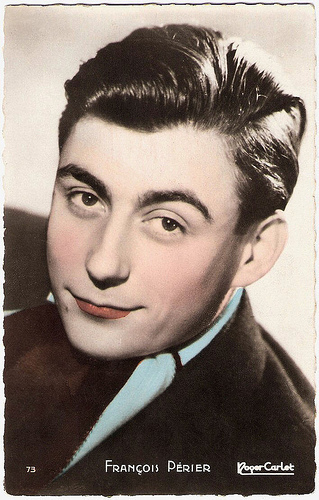
French postcard by Editions P.I., Paris, no. 73. Photo: Roger Carlet.
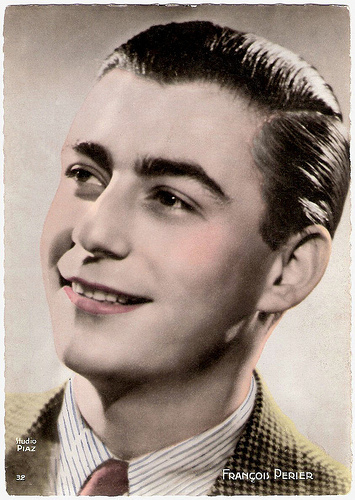
French postcard by Editions P.I., Paris, no. 32. Photo: Studio Piaz.
Magnificent Voice
François Périer’s film career started with apprenticing in bit parts.
His first notable roles were in Hôtel du Nord (Marcel Carné, 1938) with Annabella and Louis Jouvet , and La fin du jour/The End of the Day (Julien Duvivier, 1939) with Victor Francen and Jouvet.
Périer truly hit his stride in the years following World War II in films like Un revenant/A Lover's Return (Christian-Jacque, 1946) with Louis Jouvet, and La vie en rose/A Merry Life (Jran Faurez, 1947) with Louis Salou.
He co-starred with Maurice Chevalier in Le silence est d'or/Silence Is Golden (René Clair, 1947) about the heyday of the silent film, the 1920s.
His most famous screen role was Heurtebise in Jean Cocteau's Orphée/Orpheus (1950), a characterization he repeated ten years later in Le Testament D'Orphée/The Testament of Orpheus (Jean Cocteau, 1959).
There were many links between Périer's stage work and his appearances in films, television dramas and on radio programs, where his magnificent voice could be heard in all its intimate velvet best.
He was also the French narrator in Walt Disney’s animation feature Fantasia (1940).
In 1957 he won the British Oscar, the BAFTA Film Award for Best Foreign Actor for his role in Gervaise (René Clément, 1956), an adaptation of Emile Zola's L'Assommoir.
Another great role was the bookish Oscar in Fellini's Le Notte di Cabiria/Nights of Cabiria (Federico Fellini, 1957) opposite Giulietta Masina .
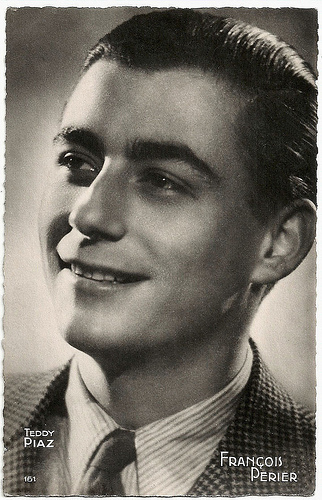
French postcard by Editions O.P., Paris, no. 161. Photo: Teddy Piaz.
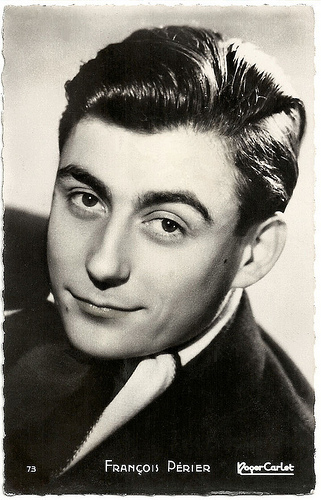
French postcard by Editions P.I., Paris, no. 73. Photo: Roger Carlet.
Professional Fibber
François Périer appeared in projects ranging from romantic comedies to political thrillers.
Among his best films of the 196’s are the thriller Le Samourai/The Godson (Jean-Pierre Melville, 1967) starring Alain Delon , the political thriller Z (Costa-Gravas, 1969), in which he played a Public Prosecutor in Greece under military rule, and the crime film Le cercle rouge (Jean-Pierre Melville, 1970) with Delon and Yves Montand .
During the following decade he appeared in supporting roles in successful films like Max et les ferrailleurs/Max and the Junkmen (Claude Sautet, 1971) starring Michel Piccoli and Romy Schneider , Juste avant la nuit (Claude Chabrol, 1971) with Stéphane Audran , L'attentat/The Assassination (Yves Boisset, 1972) about the Ben Barka affair, Stavisky (Alain Resnais, 1974) about a famous financial scandal, and Police Python 357 (Alain Corneau, 1976) opposite Yves Montand and Simone Signoret .
Périer appeared in the popular Italian TV-series La piovra/The Octopus (Damiano Damiani, 1984) starring Michele Placido.
In 1989 he published his memoirs, Profession menteur (Professional Fibber), and in 1995 followed a second book, Lettres à un jeune comédien (Letters to a Young Comedian).
Among his later films were Soigne ta droite/Keep Up Your Right (Jean-Luc Godard, 1987) and Lacenaire/The Elegant Criminal (Francis Girod, 1990) a biography of the poet-criminal Lacenaire.
In 1991, the actor began suffering from Alzheimer's disease but he worked on radio until 1996.
In 2002, François Périer died from a heart attack in Paris, at age 82. He had been married three times. He was first married to Jacqueline Porel from 1941 till 1947. In 1949 he married actress Marie Daëms. They separated in 1959. In 1961 he married Colette Boutouland and the pair stayed together till his death.
With Jacqueline Porel he had one daughter, journalist Anne-Marie Périer, and two sons. His son Jean-Pierre Périer-Pillu committed suicide at the age of 23 in 1966 by jumping from a window. His adopted son Jean-Marie Périer is a famous photographer of the yé-ye years (the French beat period).
In 2005 François Périer was awarded the Prix du Brigadier posthumously, a prize for his prolific career of nearly sixty years.
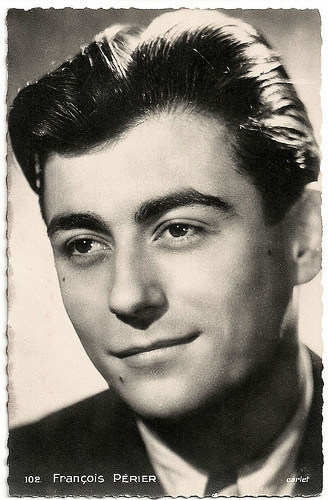
French postcard by Editions E.C., Paris, no. 102. Photo: Roger Carlet.
Trailer Stavisky (1974). Source: Film&Clips (YouTube).
Sources: James Kirkup (The Independent), Hal Erickson (AllMovie), (IMDb), Wikipedia and .

French postcard by S.E.R.P., Paris, no. 25. Photo: Studio Harcourt.

French postcard by Editions P.I., Paris, offered by Les Carbones Korès Carboplane, no. 968.
Fresh-faced, Impudent Adolescent Charm
François Périer was born Francois Marie Gabriel Pillu in Paris, in 1919. His father managed a wine shop.
At age 14, while he was still a pupil at the Lycée Janson-de-Sully, he started studying acting at the Cours René Simon. He got an audition with no less than the legendary actor Louis Jouvet . Jouvet subsequently helped him enter the Conservatoire.
He started his career at the theatre and at the age of 19, he already became a star.
In his obituary in The Independent, James Kirkup wrote about Périer: “Though he was by no means possessed of classic good looks, his fresh-faced, impudent adolescent charm attracted favourable notice when he appeared in Claude-André Puget's delightful comedy of young love Les Jours heureux (Happy Days), a success that kicked off his career with 500 performances and assured his acting future”.
Périer appeared the following decades in all kinds of plays, from the very highest intellectual dramas to the lightest of satirical intrigues. He could illuminate difficult roles and transform a nondescript drama by sheer force of talent, technique and charm.
Among his most notable stage roles was that of Hugo in the first production of Jean-Paul Sartre's Les Mains Sales in 1948. Sartre was his second great idol and Périer also appeared in Sartre's Le Diable et le Bon Dieu (1948), which was revived in 1968 and 1970 on the Théâtre du Chaillot's vast stage.
Later stage triumphs in Sartre plays included his appearance in Les Séquestrés d'Altona (The Condemned of Altona), which he also directed, in 1965.
Kirkup: “With the development of a wonderful organ of a voice, his range was limitless. He could endow even the most repulsive characters with a fascinating appeal, like his Salieri in Peter Shaffer's Amadeus opposite Roman Polanski in the title role (1982), or the sad hero of Arthur Miller's Death of a Salesman (1988) which had audiences in tears every night.”

French postcard by Editions P.I., Paris, no. 73. Photo: Roger Carlet.

French postcard by Editions P.I., Paris, no. 32. Photo: Studio Piaz.
Magnificent Voice
François Périer’s film career started with apprenticing in bit parts.
His first notable roles were in Hôtel du Nord (Marcel Carné, 1938) with Annabella and Louis Jouvet , and La fin du jour/The End of the Day (Julien Duvivier, 1939) with Victor Francen and Jouvet.
Périer truly hit his stride in the years following World War II in films like Un revenant/A Lover's Return (Christian-Jacque, 1946) with Louis Jouvet, and La vie en rose/A Merry Life (Jran Faurez, 1947) with Louis Salou.
He co-starred with Maurice Chevalier in Le silence est d'or/Silence Is Golden (René Clair, 1947) about the heyday of the silent film, the 1920s.
His most famous screen role was Heurtebise in Jean Cocteau's Orphée/Orpheus (1950), a characterization he repeated ten years later in Le Testament D'Orphée/The Testament of Orpheus (Jean Cocteau, 1959).
There were many links between Périer's stage work and his appearances in films, television dramas and on radio programs, where his magnificent voice could be heard in all its intimate velvet best.
He was also the French narrator in Walt Disney’s animation feature Fantasia (1940).
In 1957 he won the British Oscar, the BAFTA Film Award for Best Foreign Actor for his role in Gervaise (René Clément, 1956), an adaptation of Emile Zola's L'Assommoir.
Another great role was the bookish Oscar in Fellini's Le Notte di Cabiria/Nights of Cabiria (Federico Fellini, 1957) opposite Giulietta Masina .

French postcard by Editions O.P., Paris, no. 161. Photo: Teddy Piaz.

French postcard by Editions P.I., Paris, no. 73. Photo: Roger Carlet.
Professional Fibber
François Périer appeared in projects ranging from romantic comedies to political thrillers.
Among his best films of the 196’s are the thriller Le Samourai/The Godson (Jean-Pierre Melville, 1967) starring Alain Delon , the political thriller Z (Costa-Gravas, 1969), in which he played a Public Prosecutor in Greece under military rule, and the crime film Le cercle rouge (Jean-Pierre Melville, 1970) with Delon and Yves Montand .
During the following decade he appeared in supporting roles in successful films like Max et les ferrailleurs/Max and the Junkmen (Claude Sautet, 1971) starring Michel Piccoli and Romy Schneider , Juste avant la nuit (Claude Chabrol, 1971) with Stéphane Audran , L'attentat/The Assassination (Yves Boisset, 1972) about the Ben Barka affair, Stavisky (Alain Resnais, 1974) about a famous financial scandal, and Police Python 357 (Alain Corneau, 1976) opposite Yves Montand and Simone Signoret .
Périer appeared in the popular Italian TV-series La piovra/The Octopus (Damiano Damiani, 1984) starring Michele Placido.
In 1989 he published his memoirs, Profession menteur (Professional Fibber), and in 1995 followed a second book, Lettres à un jeune comédien (Letters to a Young Comedian).
Among his later films were Soigne ta droite/Keep Up Your Right (Jean-Luc Godard, 1987) and Lacenaire/The Elegant Criminal (Francis Girod, 1990) a biography of the poet-criminal Lacenaire.
In 1991, the actor began suffering from Alzheimer's disease but he worked on radio until 1996.
In 2002, François Périer died from a heart attack in Paris, at age 82. He had been married three times. He was first married to Jacqueline Porel from 1941 till 1947. In 1949 he married actress Marie Daëms. They separated in 1959. In 1961 he married Colette Boutouland and the pair stayed together till his death.
With Jacqueline Porel he had one daughter, journalist Anne-Marie Périer, and two sons. His son Jean-Pierre Périer-Pillu committed suicide at the age of 23 in 1966 by jumping from a window. His adopted son Jean-Marie Périer is a famous photographer of the yé-ye years (the French beat period).
In 2005 François Périer was awarded the Prix du Brigadier posthumously, a prize for his prolific career of nearly sixty years.

French postcard by Editions E.C., Paris, no. 102. Photo: Roger Carlet.
Trailer Stavisky (1974). Source: Film&Clips (YouTube).
Sources: James Kirkup (The Independent), Hal Erickson (AllMovie), (IMDb), Wikipedia and .
Published on April 09, 2014 23:00
April 8, 2014
Timothy Dalton
Green-eyed Timothy Dalton (1944) is a British, classically trained Shakespearean actors who had successful careers in theatre, television and film. He is best known as James Bond in The Living Daylights (1987) and Licence to Kill (1989).
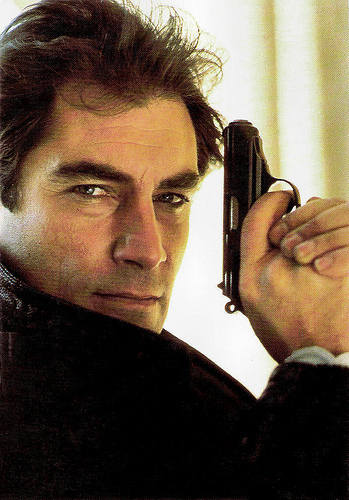
British postcard by Danjaq A.S. / United Artists, 1987. Photo: publicity still for The Living Daylights (John Glen, 1987).
Talent and Classic Good Looks
The oldest of five children, Timothy Peter Dalton was born in Colwyn Bay, North Wales in 1944. He had an English father and an American mother of Italian and Irish descent. His father was stationed there during WWII, but moved the family to Manchester in the late 1940s to work in advertising.
Timothy was fascinated with acting from a young age. After leaving Herbert Strutt Grammar School at the age of sixteen, he toured as a leading member of Michael Croft's National Youth Theater.
Between 1964-1966, he studied at The Royal Academy of Dramatic Art (RADA). Just before completing his two years, he quit and joined the Birmingham Repertory Theatre, playing the lead in many productions under the direction of Peter Dews while at the same time turning professional.
His talent and classic good looks immediately landed him professional work in television, guest-starring on an episode of the short-lived TV series, Judge Dee (1969), and as a regular on the 14-episode series Sat'day While Sunday (1967) with the young Malcolm McDowell.
In late 1967 Peter O'Toole recommended him for the role of the young King Philip of France in the period drama The Lion in Winter (Anthony Harvey, 1968). The critically acclaimed film was a commercial success and won three Academy Awards.
The following year, he starred in the Italian film Giochi particolari/The Voyeur (Franco Indovina, 1970) with Marcello Mastroianni and Virna Lisi .
Also during this time, he was approached and tested for the role of James Bond in On Her Majesty's Secret Service (1969) but turned it down, feeling he was too young for the part.
His next film was another costume drama, Cromwell (1970), working with director Ken Hughes, with whom he later made his first American film, Sextette (1978).
He followed Cromwell with other period dramas like Wuthering Heights (Robert Fuest 1970) in which he portrayed Heathcliff, and Mary, Queen of Scots (Charles Jarrott, 1971) starring Vanessa Redgrave and Glenda Jackson .
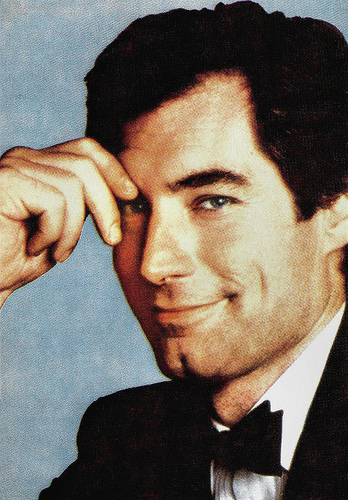
Romanian postcard by Casa Filmului Acin.
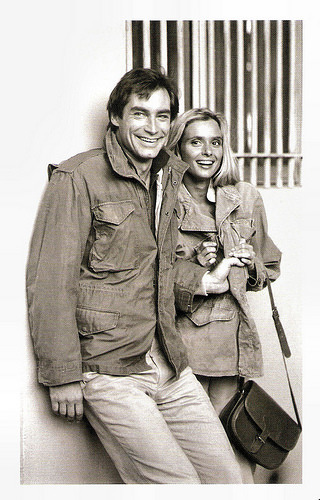
French postcard by Danjaq A.S. / United Artists, 1987. Photo: publicity still for The Living Daylights (John Glen, 1987) with Maryam d'Abo.
A Darker and More Serious James Bond
From the early to mid-1970s, Timothy Dalton decided to further hone his skills by going back into the theatre full time. He signed on with the Royal Shakespeare Company (RSC) and the Prospect Theatre Company (PTC), and toured the world with both.
In 1975, he returned to the cinema in the spy thriller Permission to Kill (Cyril Frankel, 1975) starring Dirk Bogarde . It was followed in 1976 by the Spanish religious historical film about the inquisition, El hombre que supo amar/The Man Who Knew Love (Miguel Picazo, 1978), which was never widely released.
After this, followed his first American film, the comedy/musical Sextette (Ken Hughes, 1978) as the husband of 85-year-old Mae West, and the American miniseries Centennial (1978), with Lynn Redgrave as his wife.
After this, he began to get more frequent film and television work in the US, including the episode Fallen Angel of the TV series Charlie's Angels (1976).
In England, he starred on TV as Rochester in the BBC's very popular Jane Eyre (1983). Although most of his work until 1985 consisted of TV movies and miniseries, he did a few features. He played Vanessa Redgrave 's husband in Agatha (Michael Apted, 1979), and Prince Barin in the campy Flash Gordon (Mike Hodges, 1980).
Dalton followed this with a small film, Chanel Solitaire (George Kaczender, 1981) featuring Marie-France Pisier, and filmed a staged production of Antony and Cleopatra (1983) opposite Lynn Redgrave.
The years 1983-1987 were the most prolific of his career. The world was playing a guessing game as to who would succeed Roger Moore as James Bond. Dalton was approached but was committed to the theatre, and so Pierce Brosnan was offered the part. When Brosnan was unable to get out of his Remington Steele contract at the last minute, Dalton was again approached. Able now to work it into his tight schedule, he agreed.
His first outing as Bond, The Living Daylights (John Glen, 1987), was critically successful, and grossed more than the previous two Bond films with Roger Moore.
The second, Licence to Kill (John Glen, 1989), although almost as successful as its predecessor in most markets, did not perform as well at the US box office, in large part due to a lacklustre marketing campaign. Dalton's portrayal of Bond was darker and more serious than the light-hearted playboy of Roger Moore . Dalton's interpretation of Bond was obviously closer to the gritty realism of Ian Fleming's novels.
In the mid-to-late 1980s, Dalton also narrated many nature documentaries. And he teamed with Vanessa Redgrave for a revival of The Taming of the Shrew (1988) and his interpretation of Petrucchio received uniformly high praise.
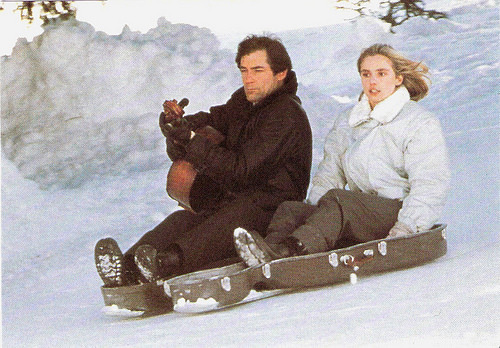
French postcard by Danjaq A.S. / United Artists, 1987. Photo: publicity still for The Living Daylights (John Glen, 1987) with Maryam d'Abo.
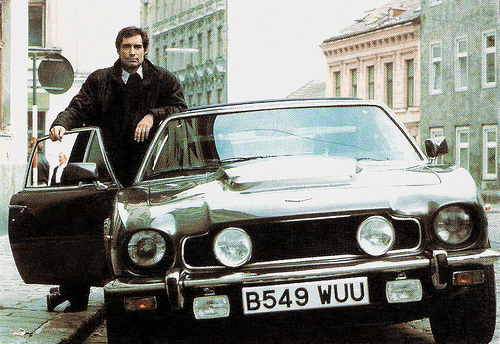
French postcard by Danjaq A.S. / United Artists, 1987. Photo: publicity still for The Living Daylights (John Glen, 1987).
Rhett Butler
Following Licence to Kill (1989), Timothy Dalton returned to one of his strengths, costume drama, in La putain du roi/The King's Whore (Axel Corti, 1990) with Valeria Golino.
It was followed by his excellent performance in Disney's The Rocketeer (Joe Johnston, 1991), where he played a swashbuckling, Errol Flynn type.
In 1992, he starred in the TV mini-series Framed (Geoffrey Sax, 1992), which won a bronze medal at the 1993 New York Film Festival.
In 1994, he took on the role of Rhett Butler in the eight-hour mini-series Scarlett (John Erman, 1994), an original sequel to Gone with the Wind (Victor Fleming, 1939). Scarlett, featuring Joanne Whalley, was a ratings success all over the world.
Dalton initially agreed to play James Bond for a third time in GoldenEye (Martin Campbell, 1995), but after a lengthy series of lawsuits between the studio and producers concerning the ownership of the character James Bond, and further script delays, he resigned from the role. He believed that too much time had passed since Licence to Kill (1989). The role went to Pierce Brosnan.
Dalton’s later films include the IRA drama The Informant (Jim McBride, 1997), The Reef (Robert Allan Ackerman, 1999), opposite Sela Ward, and the comedy The Beautician and the Beast (Ken Kwapis, 1997) co-starring Fran Drescher.
He gleefully parodied his swashbuckling/James Bond image in Looney Tunes: Back in Action (Joe Dante, 2003) as a spy playing an actor playing a spy.
More recently he was seen in The Tourist (2010) with Angelina Jolie and Johnny Depp.
Between 1980 and 1994, Timothy Dalton was the companion of Vanessa Redgrave . In 1995, Dalton began a relationship with Russian musician Oksana Grigorieva, with whom he has a son, Alexander (1997). Dalton lives in London, England and Los Angeles, California.
Trailer Sextette (1978). Source: Movieclips Classic Trailers (YouTube).
Trailer The Living Daylights (1987). Source AgelessTrailers (YouTube).
Sources: Wikipedia and .

British postcard by Danjaq A.S. / United Artists, 1987. Photo: publicity still for The Living Daylights (John Glen, 1987).
Talent and Classic Good Looks
The oldest of five children, Timothy Peter Dalton was born in Colwyn Bay, North Wales in 1944. He had an English father and an American mother of Italian and Irish descent. His father was stationed there during WWII, but moved the family to Manchester in the late 1940s to work in advertising.
Timothy was fascinated with acting from a young age. After leaving Herbert Strutt Grammar School at the age of sixteen, he toured as a leading member of Michael Croft's National Youth Theater.
Between 1964-1966, he studied at The Royal Academy of Dramatic Art (RADA). Just before completing his two years, he quit and joined the Birmingham Repertory Theatre, playing the lead in many productions under the direction of Peter Dews while at the same time turning professional.
His talent and classic good looks immediately landed him professional work in television, guest-starring on an episode of the short-lived TV series, Judge Dee (1969), and as a regular on the 14-episode series Sat'day While Sunday (1967) with the young Malcolm McDowell.
In late 1967 Peter O'Toole recommended him for the role of the young King Philip of France in the period drama The Lion in Winter (Anthony Harvey, 1968). The critically acclaimed film was a commercial success and won three Academy Awards.
The following year, he starred in the Italian film Giochi particolari/The Voyeur (Franco Indovina, 1970) with Marcello Mastroianni and Virna Lisi .
Also during this time, he was approached and tested for the role of James Bond in On Her Majesty's Secret Service (1969) but turned it down, feeling he was too young for the part.
His next film was another costume drama, Cromwell (1970), working with director Ken Hughes, with whom he later made his first American film, Sextette (1978).
He followed Cromwell with other period dramas like Wuthering Heights (Robert Fuest 1970) in which he portrayed Heathcliff, and Mary, Queen of Scots (Charles Jarrott, 1971) starring Vanessa Redgrave and Glenda Jackson .

Romanian postcard by Casa Filmului Acin.

French postcard by Danjaq A.S. / United Artists, 1987. Photo: publicity still for The Living Daylights (John Glen, 1987) with Maryam d'Abo.
A Darker and More Serious James Bond
From the early to mid-1970s, Timothy Dalton decided to further hone his skills by going back into the theatre full time. He signed on with the Royal Shakespeare Company (RSC) and the Prospect Theatre Company (PTC), and toured the world with both.
In 1975, he returned to the cinema in the spy thriller Permission to Kill (Cyril Frankel, 1975) starring Dirk Bogarde . It was followed in 1976 by the Spanish religious historical film about the inquisition, El hombre que supo amar/The Man Who Knew Love (Miguel Picazo, 1978), which was never widely released.
After this, followed his first American film, the comedy/musical Sextette (Ken Hughes, 1978) as the husband of 85-year-old Mae West, and the American miniseries Centennial (1978), with Lynn Redgrave as his wife.
After this, he began to get more frequent film and television work in the US, including the episode Fallen Angel of the TV series Charlie's Angels (1976).
In England, he starred on TV as Rochester in the BBC's very popular Jane Eyre (1983). Although most of his work until 1985 consisted of TV movies and miniseries, he did a few features. He played Vanessa Redgrave 's husband in Agatha (Michael Apted, 1979), and Prince Barin in the campy Flash Gordon (Mike Hodges, 1980).
Dalton followed this with a small film, Chanel Solitaire (George Kaczender, 1981) featuring Marie-France Pisier, and filmed a staged production of Antony and Cleopatra (1983) opposite Lynn Redgrave.
The years 1983-1987 were the most prolific of his career. The world was playing a guessing game as to who would succeed Roger Moore as James Bond. Dalton was approached but was committed to the theatre, and so Pierce Brosnan was offered the part. When Brosnan was unable to get out of his Remington Steele contract at the last minute, Dalton was again approached. Able now to work it into his tight schedule, he agreed.
His first outing as Bond, The Living Daylights (John Glen, 1987), was critically successful, and grossed more than the previous two Bond films with Roger Moore.
The second, Licence to Kill (John Glen, 1989), although almost as successful as its predecessor in most markets, did not perform as well at the US box office, in large part due to a lacklustre marketing campaign. Dalton's portrayal of Bond was darker and more serious than the light-hearted playboy of Roger Moore . Dalton's interpretation of Bond was obviously closer to the gritty realism of Ian Fleming's novels.
In the mid-to-late 1980s, Dalton also narrated many nature documentaries. And he teamed with Vanessa Redgrave for a revival of The Taming of the Shrew (1988) and his interpretation of Petrucchio received uniformly high praise.

French postcard by Danjaq A.S. / United Artists, 1987. Photo: publicity still for The Living Daylights (John Glen, 1987) with Maryam d'Abo.

French postcard by Danjaq A.S. / United Artists, 1987. Photo: publicity still for The Living Daylights (John Glen, 1987).
Rhett Butler
Following Licence to Kill (1989), Timothy Dalton returned to one of his strengths, costume drama, in La putain du roi/The King's Whore (Axel Corti, 1990) with Valeria Golino.
It was followed by his excellent performance in Disney's The Rocketeer (Joe Johnston, 1991), where he played a swashbuckling, Errol Flynn type.
In 1992, he starred in the TV mini-series Framed (Geoffrey Sax, 1992), which won a bronze medal at the 1993 New York Film Festival.
In 1994, he took on the role of Rhett Butler in the eight-hour mini-series Scarlett (John Erman, 1994), an original sequel to Gone with the Wind (Victor Fleming, 1939). Scarlett, featuring Joanne Whalley, was a ratings success all over the world.
Dalton initially agreed to play James Bond for a third time in GoldenEye (Martin Campbell, 1995), but after a lengthy series of lawsuits between the studio and producers concerning the ownership of the character James Bond, and further script delays, he resigned from the role. He believed that too much time had passed since Licence to Kill (1989). The role went to Pierce Brosnan.
Dalton’s later films include the IRA drama The Informant (Jim McBride, 1997), The Reef (Robert Allan Ackerman, 1999), opposite Sela Ward, and the comedy The Beautician and the Beast (Ken Kwapis, 1997) co-starring Fran Drescher.
He gleefully parodied his swashbuckling/James Bond image in Looney Tunes: Back in Action (Joe Dante, 2003) as a spy playing an actor playing a spy.
More recently he was seen in The Tourist (2010) with Angelina Jolie and Johnny Depp.
Between 1980 and 1994, Timothy Dalton was the companion of Vanessa Redgrave . In 1995, Dalton began a relationship with Russian musician Oksana Grigorieva, with whom he has a son, Alexander (1997). Dalton lives in London, England and Los Angeles, California.
Trailer Sextette (1978). Source: Movieclips Classic Trailers (YouTube).
Trailer The Living Daylights (1987). Source AgelessTrailers (YouTube).
Sources: Wikipedia and .
Published on April 08, 2014 23:00
April 7, 2014
Carl Auen
German film actor Carl Auen (1892–1972) often appeared in silent films as the handsome gentleman, officer or nobleman. Between 1914 and 1938 he appeared in 119 films.
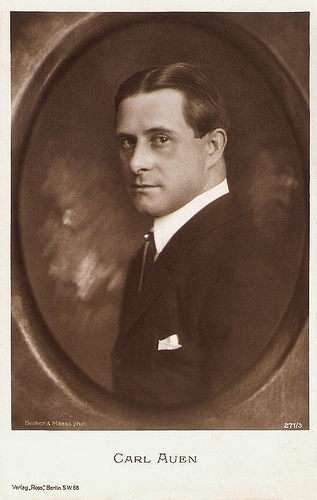
German postcard by Ross Verlag, no. 271/3, 1919-1924. Photo: Becker & Maass.
Detective Joe Deebs
Carl Theodor Auen was born in Düsseldorf, Germany in 1892.
In 1914 he appeared in the short silent film Die geheimnisvolle Villa/The secret villa, directed by Joe May and written by Ernst Reicher. It was a crime film which featured Ernst Reicher as the detective Stuart Webbs. In the cast were also Werner Krauss , Max Landa , Mia May and her daughter Eva May , who all would become well known silent film stars.
Auen often worked with such directors as Franz Hofer, William Kahn, Leo Lasko and Wolfgang Neff.
He was successful with two film series, one in which he played the criminologist Rat Anheim (1917-1918) and in the other he was the detective Joe Deebs (1919-1920), replacing Max Landa .
The highlight of his career was in the 1920s, when he starred in successful films as Frauenschicksal/Women's destiny (Guido Schamberg, 1922) with Marcella Albani , Lyda Ssanin ( Friedrich Zelnik , 1923) featuring Lyda Mara , Aschermittwoch/Ash Wednesday (Wolfgang Neff, 1925) and Einer gegen Alle/One against all (Nunzio Malasomma, 1927) with Carlo Aldini .
In 1927, Auen also had a supporting part in the German silent film Der falsche Prinz/The False Prince (Heinz Paul, 1927) starring Harry Domela. The film was based on Domela's own book recounting his adventures in post-First World War Germany when he briefly masqueraded as Prince.
Two years later Auen appeared as a defender in the drama Meineid/Perjury (Georg Jacoby, 1929) starring Alice Roberts, Franz Lederer and Miles Mander.
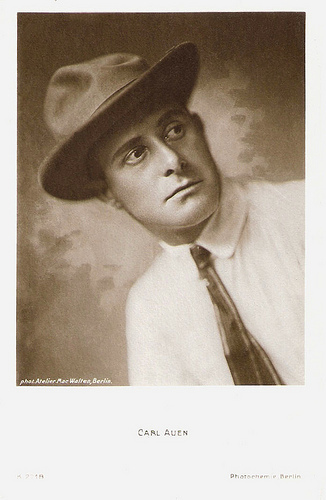
German postcard by Photochemie, Berlin, no. K. 2218. Photo: Atelier Mac Walten, Berlin.
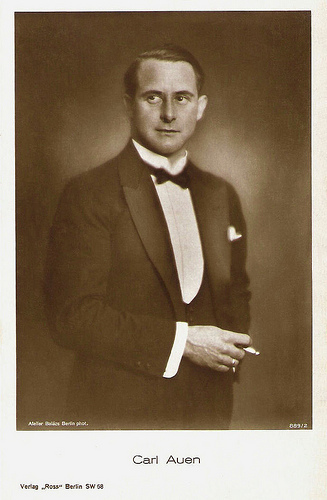
German postcard by Ross Verlag, no. 889/2, 1925-1926. Photo: Balázs, Berlin.
Reichsfilmkammer
After 107 silent films, Carl Auen continued his career during the sound era. The now 40-years old Auen only played supporting roles.
He had a small part in the Swiss–German war film Tannenberg (Heinz Paul, 1932), based around the 1914 Battle of Tannenberg during the First World War.
That year he also appeared in the comedy thriller Es geht um alles/All is at Stake (Max Nosseck, 1932) starring Luciano Albertini .
It was followed by the film operetta Die Blume von Hawaii/The Flower of Hawaii (Richard Oswald, 1933), an adaptation of the operetta The Flower of Hawaii by Paul Abraham starring Márta Eggerth .
Before Hitler came to power, Auen had joined the anti-semitic Kampfbund für deutsche Kultur (KfdK) and the Betriebszellen-Organisation (National Socialist Factory Cell Organization), a workers organization in Nazi Germany.
Joseph Goebbels appointed him in 1933 to head the film student council of the Reichsfilmkammer (Film Chamber of the Reich), a key position in the personnel policy within the Nazi film industry.
In 1937 Auen played a police officer in the propaganda film Togger (Jürgen von Alten, 1937) and he had a small part in Richard Eichberg's two-part adventure film Der Tiger von Eschnapur/The Tiger of Eschnapur (Richard Eichberg, 1938) and Das indische Grabmal/The Indian Tomb (Richard Eichberg, 1938) starring La Jana and Frits van Dongen .
His last film role was in the crime film Mit versiegelter Order/With sealed orders (Karl Anton, 1938) with Viktor de Kowa .
After World War II he worked as a representative for liquor.
Completely forgotten, Carl Auen died in 1972 in Berlin. He was 80.
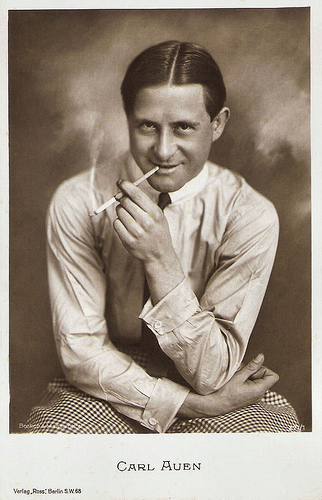
German postcard by Ross Verlag, no. 271/1, 1919-1924. Photo: Becker & Maas, Berlin.
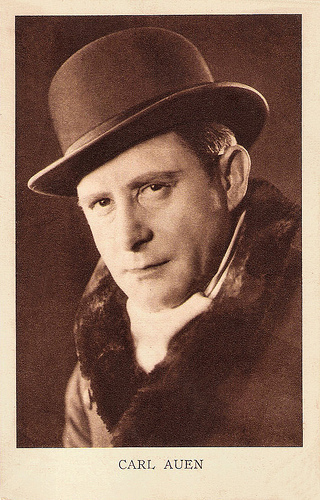
Belgian postcard by Edition S.A. Cacao et Chocolat Kivou, Vilvoorde.
Sources: Stephanie D’heil (Steffi-Line), Thomas Staedeli (Cyranos), Filmportal.de, Wikipedia (English and German), and .

German postcard by Ross Verlag, no. 271/3, 1919-1924. Photo: Becker & Maass.
Detective Joe Deebs
Carl Theodor Auen was born in Düsseldorf, Germany in 1892.
In 1914 he appeared in the short silent film Die geheimnisvolle Villa/The secret villa, directed by Joe May and written by Ernst Reicher. It was a crime film which featured Ernst Reicher as the detective Stuart Webbs. In the cast were also Werner Krauss , Max Landa , Mia May and her daughter Eva May , who all would become well known silent film stars.
Auen often worked with such directors as Franz Hofer, William Kahn, Leo Lasko and Wolfgang Neff.
He was successful with two film series, one in which he played the criminologist Rat Anheim (1917-1918) and in the other he was the detective Joe Deebs (1919-1920), replacing Max Landa .
The highlight of his career was in the 1920s, when he starred in successful films as Frauenschicksal/Women's destiny (Guido Schamberg, 1922) with Marcella Albani , Lyda Ssanin ( Friedrich Zelnik , 1923) featuring Lyda Mara , Aschermittwoch/Ash Wednesday (Wolfgang Neff, 1925) and Einer gegen Alle/One against all (Nunzio Malasomma, 1927) with Carlo Aldini .
In 1927, Auen also had a supporting part in the German silent film Der falsche Prinz/The False Prince (Heinz Paul, 1927) starring Harry Domela. The film was based on Domela's own book recounting his adventures in post-First World War Germany when he briefly masqueraded as Prince.
Two years later Auen appeared as a defender in the drama Meineid/Perjury (Georg Jacoby, 1929) starring Alice Roberts, Franz Lederer and Miles Mander.

German postcard by Photochemie, Berlin, no. K. 2218. Photo: Atelier Mac Walten, Berlin.

German postcard by Ross Verlag, no. 889/2, 1925-1926. Photo: Balázs, Berlin.
Reichsfilmkammer
After 107 silent films, Carl Auen continued his career during the sound era. The now 40-years old Auen only played supporting roles.
He had a small part in the Swiss–German war film Tannenberg (Heinz Paul, 1932), based around the 1914 Battle of Tannenberg during the First World War.
That year he also appeared in the comedy thriller Es geht um alles/All is at Stake (Max Nosseck, 1932) starring Luciano Albertini .
It was followed by the film operetta Die Blume von Hawaii/The Flower of Hawaii (Richard Oswald, 1933), an adaptation of the operetta The Flower of Hawaii by Paul Abraham starring Márta Eggerth .
Before Hitler came to power, Auen had joined the anti-semitic Kampfbund für deutsche Kultur (KfdK) and the Betriebszellen-Organisation (National Socialist Factory Cell Organization), a workers organization in Nazi Germany.
Joseph Goebbels appointed him in 1933 to head the film student council of the Reichsfilmkammer (Film Chamber of the Reich), a key position in the personnel policy within the Nazi film industry.
In 1937 Auen played a police officer in the propaganda film Togger (Jürgen von Alten, 1937) and he had a small part in Richard Eichberg's two-part adventure film Der Tiger von Eschnapur/The Tiger of Eschnapur (Richard Eichberg, 1938) and Das indische Grabmal/The Indian Tomb (Richard Eichberg, 1938) starring La Jana and Frits van Dongen .
His last film role was in the crime film Mit versiegelter Order/With sealed orders (Karl Anton, 1938) with Viktor de Kowa .
After World War II he worked as a representative for liquor.
Completely forgotten, Carl Auen died in 1972 in Berlin. He was 80.

German postcard by Ross Verlag, no. 271/1, 1919-1924. Photo: Becker & Maas, Berlin.

Belgian postcard by Edition S.A. Cacao et Chocolat Kivou, Vilvoorde.
Sources: Stephanie D’heil (Steffi-Line), Thomas Staedeli (Cyranos), Filmportal.de, Wikipedia (English and German), and .
Published on April 07, 2014 23:00
Paul van Yperen's Blog
- Paul van Yperen's profile
- 13 followers
Paul van Yperen isn't a Goodreads Author
(yet),
but they
do have a blog,
so here are some recent posts imported from
their feed.



